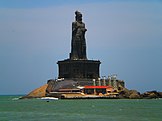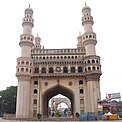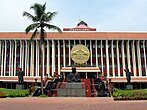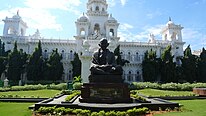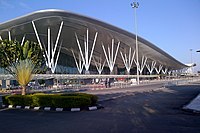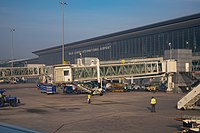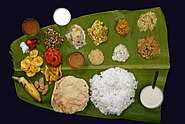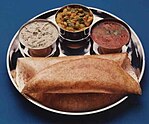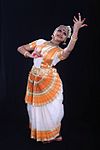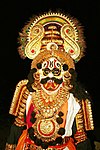South India
South India
Peninsular India | |
|---|---|
 States and union territories in South India | |
| Country | |
| States and union territories | |
| Most populous cities | |
| Area | |
• City | 635,780 km2 (245,480 sq mi) |
| Highest elevation (Anamudi) | 2,695 m (8,842 ft) |
| Lowest elevation (Kuttanad) | −2.2 m (−7.2 ft) |
| Population (2011) | |
• City | 253,051,953 |
| • Density | 400/km2 (1,000/sq mi) |
| • Urban | 111,386,832 |
| Demonym(s) | South Indian Telugu Tamilian Kannadiga Malayali Laccadivian Pondicherrian |
| Time zone | IST (UTC+5:30) |
| Official languages[1] | |
| HDI (2019) | |
| Literacy (2011) | 76.43%[2] |
| Sex ratio (2011) | 986 ♀/1000 ♂[3] |
South India, also known as Southern India or Peninsular India, is the southern part of the Deccan Peninsula in India encompassing the states of Andhra Pradesh, Karnataka, Kerala, Tamil Nadu and Telangana as well as the union territories of Lakshadweep and Puducherry, occupying 19.31% of India's area (635,780 km2 or 245,480 sq mi) and 20% of India's population. It is bound by the Bay of Bengal in the east, the Arabian Sea in the west and the Indian Ocean in the south. The geography of the region is diverse, with two mountain ranges, the Western and Eastern Ghats, bordering the plateau heartland. The Godavari, Krishna, Kaveri, Penna, Tungabhadra and Vaigai rivers are important non-perennial sources of water. Chennai, Bangalore, Hyderabad, Coimbatore and Kochi are the largest urban areas in the region.
The majority of the people in South India speak at least one of the four major Dravidian languages: Telugu, Tamil, Kannada and Malayalam. During its history, a number of dynastic kingdoms ruled over parts of South India, and shaped the culture in those regions. Major dynasties that were established in South India include the Cheras, Cholas, Pandyas, Pallavas, Satavahanas, Chalukyas, Hoysalas, Rashtrakutas and Vijayanagara. European countries entered India through Kerala and the region was colonized by Britain, Portugal and France.
After experiencing fluctuations in the decades immediately after Indian independence, the economies of South Indian states have registered a sustained higher-than-national-average growth over the past three decades. South India has the largest combined largest gross domestic product compared to other regions in India. The South Indian states lead in some socio-economic metrics of India with a higher HDI as the economy has undergone growth at a faster rate than in most northern states. As of 2011, Literacy rates in the southern states is higher than the national average at approximately 76%. The fertility rate in South India is 1.9, the lowest of all regions in India.
Etymology
"South India" is also known as "Peninsular India" indicating its location in a peninsula surrounded by water on three sides.[4] The term "Deccan", referring to the area covered by the Deccan Plateau that covers most of peninsular India excluding the coastal areas, is an anglicised form of the Prakrit word dakkhiṇa derived from the Sanskrit word dakshiṇa meaning south.[5] Carnatic, derived from "Karnāḍ" or "Karunāḍ" meaning high country, has also been associated with South India.[6]
History
Ancient and medieval era

Carbon dating shows that ash mounds associated with Neolithic cultures in South India date back to 8000 BCE. Towards the beginning of 1000 BCE, iron technology spread through the region; however, there does not appear to be a fully developed Bronze Age preceding the Iron Age in South India.[7] The region was in the middle of a trade route that extended from Muziris to Arikamedu linking the Mediterranean to East Asia.[8][9] Trade with Phoenicians, Romans, Greeks, Arabs, Syrians, Jews, and Chinese began during the Sangam period (c. 3rd century BCE to c. 4th century CE).[10] The region was part of the ancient Silk Road connecting the East with the West.[11]
Several dynasties such as the Cheras of Karuvur, the Pandyas of Madurai, the Cholas of Thanjavur, the Zamorins of Kozhikode, the Satavahanas of Amaravati, the Pallavas of Kanchi, the Kadambas of Banavasi, the Western Gangas of Kolar, the Rashtrakutas of Manyakheta, the Chalukyas of Badami, the Hoysalas of Belur, and the Kakatiyas of Orugallu ruled over the region from the 6th century BCE to the 14th century CE. In the 15th century, Vijayanagara empire was the last kingdom to conquer all of Southern India.[12] After repeated invasions from the Sultanate of Delhi, the Vijayanagara empire fell in 1646 and the region was ruled by various Deccan Sultanates, polygars and Nayak governors of the erstwhile Vijayanagara empire who declared independence.[13]
Colonial era
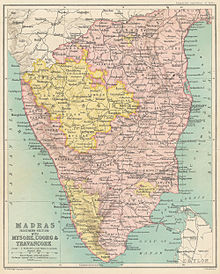
The Europeans arrived in the 15th century; and by the middle of the 18th century, the French and the British were involved in a protracted struggle for military control over South India. After the defeat of Tipu Sultan in the Fourth Anglo-Mysore War in 1799 and the end of the Vellore Mutiny in 1806, the British consolidated their power over much of present-day South India, with the exception of French Pondichéry. The British Empire took control of the region from the British East India Company in 1857.[14] During the British colonial rule, the region was divided into the Madras Presidency (later, the Madras Province), Hyderabad State, Mysore, and the Madras States Agency (composed of Travancore, Cochin, Jeypore, and a number of other minor princely states). The region played a major role in the Indian independence movement. Of the 72 delegates who participated in the first session of the Indian National Congress at Bombay in December 1885, 22 hailed from South India.[15]
Post-independence
After Indian Independence in 1947, the region was organized into four states Madras State, Mysore State, Hyderabad State and Travancore-Cochin.[16] Dravida Nadu was a proposal for a separate sovereign state for the speakers of the Dravidian languages in South India. Initially, the demand of Dravida Nadu proponents was limited to Tamil-speaking regions, but it was later expanded to include other Indian states with a majority of Dravidian-speakers in the region.[17] The States Reorganisation Act 1956, which created linguistic States, weakened the demand for a separate sovereign state.[18][19]
The States Reorganisation Act of 1956 reorganized the states based on linguistic lines resulting in the creation of the new states of Andhra Pradesh, Karnataka, Kerala and Tamil Nadu.[20][21] As a result of this act, Madras State retained its name with Kanyakumari district added to from Travancore-Cochin. The state was subsequently renamed Tamil Nadu in 1968.[22] Andhra Pradesh was created with the merger of Andhra State with the Telugu-speaking districts of Hyderabad State in 1956. Kerala was created with the merger of Malabar district and the Kasaragod taluk of South Canara districts of Madras State with Travancore-Cochin. Mysore State was re-organized with the addition of districts of Bellary and South Canara (excluding Kasaragod taluk) and the Kollegal taluk of Coimbatore district from the Madras State, the districts of Belgaum, Bijapur, North Canara and Dharwad from Bombay State, the Kannada-majority districts of Bidar, Raichur and Gulbarga from Hyderabad State and the province of Coorg.[23] Mysore State was renamed as Karnataka in 1973.[24] The Union Territory of Puducherry was created in 1954 comprising the previous French enclaves of Pondichéry, Karaikal, Yanam and Mahé.[20] The Laccadive Islands which were divided between South Canara and Malabar districts of Madras State were united and organized into the union territory of Lakshadweep.[20] Telangana was created on June 2, 2014, by bifurcating Andhra Pradesh and comprises ten districts in northwestern Andhra Pradesh.[25][26]
Geography
Topography
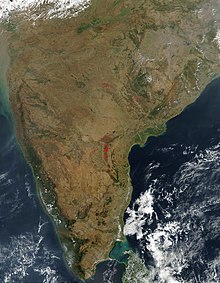
South India is a peninsula in the shape of an inverted triangle bound by Indian Ocean in the South, Arabian Sea in the west, by Bay of Bengal in the east and the Vindhya and Satpura ranges in the north.[27] The Narmada river flows westwards in the depression between the Vindhya and Satpura ranges, which define the northern spur of the Deccan plateau.[28] The low-lying coral islands of Lakshadweep are situated off the southwestern coast of India and the Andaman and Nicobar islands lie far off the eastern coast. The Palk Strait and the chain of low sandbars and islands known as Rama's Bridge separate the region from Sri Lanka, which lies off the southeastern coast.[29][30] The southernmost tip of mainland India is at Kanyakumari where the Indian Ocean meets the Bay of Bengal and the Arabian Sea.[31]
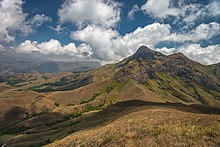
The Western Ghats runs south along the western coast from south of the Tapti River to Kanyakumari and forms a narrow strip of land with the Arabian sea called Konkan region.[32] Anai Mudi in the Anaimalai Hills 2,695 m (8,842 ft) is the highest peak in South India.[33] The Eastern Ghats run parallel to the Bay of Bengal along the eastern coast and the strip of land between them forms the Coromandel region.[34] They are a discontinuous range of mountains, which have been eroded and quadrisected by the four major rivers of southern India, the Godavari, Mahanadi, Krishna, and Kaveri.[35] Both mountain ranges meet at the Nilgiri mountains which run in a crescent approximately along the borders of Tamil Nadu with northern Kerala and Karnataka, encompassing the Palakkad and Wayanad hills and the Sathyamangalam ranges, extending to the relatively low-lying hills of the Eastern Ghats on the western portion of the Tamil Nadu–Andhra Pradesh border, forming the Tirupati and Annamalai hills.[36]
The Deccan plateau is the elevated region bound by the mountain ranges.[37] The plateau rises to 100 metres (330 ft) in the north and to more than 1 kilometre (0.62 mi) in the south, forming a raised triangle within the downward-pointing triangle of the Indian subcontinent's coastline.[38] It also slopes gently from West to East resulting in major rivers arising in the Western Ghats and flowing east into the Bay of Bengal.[39] The volcanic basalt beds of the Deccan were laid down in the massive Deccan Traps eruption, which occurred towards the end of the Cretaceous period, between 67 and 66 million years ago.[40] Layer after layer was formed by the volcanic activity that lasted many years and when the volcanoes became extinct, they left a region of highlands with typically vast stretches of flat areas on top like a table.[41] The plateau is watered by the east-flowing Godavari, Krishna, Kaveri, Penna, Tungabhadra, Vaigai rivers and their tributaries.[42]
Other prominent features include the Gulf of Mannar, the Palk Strait, which separates India from Sri Lanka; the Ten Degree Channel, which separates the Andamans from the Nicobar Islands; and the Eight Degree Channel, which separates the Laccadive and Amindivi Islands from the Minicoy Island to the south.[43] Laccadive Sea is a smaller sea.[44] There are coral reefs located in the Gulf of Mannar and Lakshadweep islands.[45] Large lakes include Vembanad Lake and Pulicat Lake.[46]
Climate
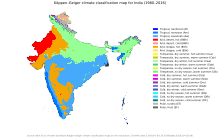

The region has a tropical climate and depends on monsoons for rainfall. According to the Köppen climate classification, it has a non-arid climate with minimum mean temperatures of 18 °C (64 °F).[47] The most humid is the tropical monsoon climate characterized by moderate to high year-round temperatures and seasonally heavy rainfall above 2,000 mm (79 in) per year. The tropical climate is experienced in a strip of south-western lowlands abutting the Malabar Coast, the Western Ghats and the Lakshadweep islands.[48]
A tropical wet and dry climate, drier than areas with a tropical monsoon climate, prevails over most of the inland peninsular region except for a semi-arid rain shadow east of the Western Ghats. Winter and early summer are long dry periods with temperatures averaging above 18 °C (64 °F); summer is exceedingly hot with temperatures in low-lying areas exceeding 50 °C (122 °F); and the rainy season lasts from June to September, with annual rainfall averaging between 750 and 1,500 mm (30 and 59 in) across the region. Once the dry northeast monsoon begins in September, most precipitation in India falls in Tamil Nadu, leaving other states comparatively dry.[49] A hot semi-arid climate predominates in the land east of the Western Ghats and the Cardamom Hills. The region – which includes Karnataka, inland Tamil Nadu and western Andhra Pradesh – gets between 400 and 750 millimetres (15.7 and 29.5 in) of rainfall annually, with hot summers and dry winters with temperatures around 20–24 °C (68–75 °F). The months between March and May are hot and dry, with mean monthly temperatures hovering around 32 °C (90 °F), with 320 millimetres (13 in) precipitation. Without artificial irrigation, this region is not suitable for agriculture.[50]
The southwest monsoon from June to September accounts for most of the rainfall in the region. The Arabian Sea branch of the southwest monsoon hits the Western Ghats along the coastal state of Kerala and moves northward along the Konkan coast, with precipitation on coastal areas west of the Western Ghats. The lofty Western Ghats prevent the winds from reaching the Deccan Plateau; hence, the leeward region (the region deprived of winds) receives very little rainfall.[51][52] The Bay of Bengal branch of the southwest monsoon heads toward northeast India, picking up moisture from the Bay of Bengal. The Coramandel coast does not receive much rainfall from the southwest monsoon, due to the shape of the land. Tamil Nadu and southeast Andhra Pradesh receive rains from the northeast monsoon.[53] The northeast monsoon takes place from November to early March, when the surface high-pressure system is strongest.[54] The North Indian Ocean tropical cyclones occur throughout the year in the Bay of Bengal and the Arabian Sea, bringing devastating winds and heavy rainfall.[55][56][57]
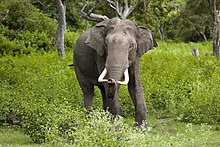
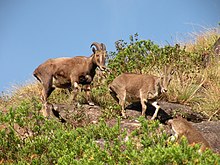
Flora and fauna
There is a wide diversity of plants and animals in South India, resulting from its varied climates and geography. Deciduous forests are found along the Western Ghats while tropical dry forests and scrub lands are common in the interior Deccan plateau. The southern Western Ghats have rain forests located at high altitudes called the South Western Ghats montane rain forests, and the Malabar Coast moist forests are found on the coastal plains.[58] The Western Ghats is one of the eight hottest biodiversity hotspots in the world and a UNESCO World Heritage Site.[59][60]
Important ecological regions of South India are the Nilgiri Biosphere Reserve in the Nilgiri Hills, the Agasthyamala Biosphere Reserve in the Agastya Mala-Cardamom Hills and Gulf of Mannar coral reefs.[61] The Gulf of Mannar Biosphere Reserve covers an area of 10,500 km2 (4,100 sq mi) of ocean, islands and the adjoining coastline including coral reefs, salt marshes and mangroves. It is home to endangered aquatic species, including dolphins, dugongs, whales and sea cucumbers.[62][63] Bird sanctuaries including Thattekad, Kadalundi, Vedanthangal, Ranganathittu, Kumarakom, Neelapattu, and Pulicat are home to numerous migratory and local birds.[64][65]
South India is home to one of the largest populations of endangered Bengal tigers and Indian elephants in India, being home to one-third of the tiger population and more than half of the elephant population,[66][67] with 14 Project Tiger reserves and 11 Project Elephant reserves.[68][69] Elephant populations are found in eight fragmented sites in the region: in northern Karnataka, along the Western Ghats, in Bhadra–Malnad, in Brahmagiri–Nilgiris–Eastern Ghats, in Nilambur–Silent Valley–Coimbatore, in Anamalai–Parambikulam, in Periyar–Srivilliputhur, and in Agasthyamalai[70] Other threatened and endangered species found in the region include the grizzled giant squirrel,[71] grey slender loris,[72] sloth bear,[73] Nilgiri tahr,[74] Nilgiri langur,[75] lion-tailed macaque,[76] and the Indian leopard.[77]
| Name | Animal | Bird | Tree | Fruit | Flower |
|---|---|---|---|---|---|
| Andhra Pradesh[79] | Blackbuck (Antilope cervicapra) | Rose-ringed parakeet (Psittacula krameri) | Neem (Azadirachta indica) | Mango (Mangifera indica) | Common jasmine (Jasminum officinale) |
| Karnataka[80] | Indian elephant (Elephas maximus) | Indian roller (Coracias indica) | Sandalwood (Santalum album) | Mango (Mangifera indica) | Lotus (Nelumbo nucifera) |
| Kerala[81] | Indian elephant (Elephas maximus) | Great hornbill (Buceros bicornis) | Coconut (Cocos nucifera) | Jackfruit (Artocarpus heterophyllus) | Cana fistula (Cassia fistula) |
| Lakshadweep[82] | Butterfly fish (Chaetodon falcula) | Noddy tern (Anous stolidus) | Bread fruit (Artocarpus incisa) | ||
| Puducherry[83] | Indian palm squirrel (Funambulus palmarum) | Koel (Eudynamys scolopaceus) | Bael fruit (Aegle marmelos) | Cannonball (Couroupita guianensis) | |
| Tamil Nadu[84] | Nilgiri tahr (Nilgiritragus hylocrius) | Emerald dove (Chalcophaps indica) | Palmyra palm (Borassus flabellifer) | Jackfruit (Artocarpus heterophyllus) | Glory lily (Gloriosa superba) |
| Telangana[85] | Chital deer (Axis axis) | Indian roller (Coracias indica) | Khejri (Prosopis cineraria) | Mango (Mangifera indica) | Tanner's cassia (Senna auriculata) |
Politics
Politics in South India is characterized by a mix of regional and national political parties. The Justice Party and Swaraj Party were the two major parties in the erstwhile Madras Presidency.[86] The Justice Party eventually lost the 1937 elections to the Indian National Congress, and Chakravarti Rajagopalachari became the Chief Minister of the Madras Presidency.[86] During the 1920s and 1930s, the Self-Respect Movement, spearheaded by Theagaroya Chetty and E. V. Ramaswamy (commonly known as Periyar), emerged in the Madras Presidency.[87] In 1944, Periyar transformed the party into a social organisation, renaming the party Dravidar Kazhagam, and withdrew from electoral politics. The initial aim was the secession of Dravida Nadu from the rest of India upon Indian independence. After independence, C. N. Annadurai, a follower of Periyar, formed the Dravida Munnetra Kazhagam (DMK) in 1948. The Anti-Hindi agitations of Tamil Nadu led to the rise of Dravidian parties that formed Tamil Nadu's first government, in 1967. In 1972, a split in the DMK resulted in the formation of the All India Anna Dravida Munnetra Kazhagam (AIADMK) led by M. G. Ramachandran. Dravidian parties continue to dominate Tamil Nadu electoral politics, the national parties usually aligning as junior partners to the major Dravidian parties, AIADMK and DMK.[88][89]
Indian National Congress dominated the political scene in Tamil Nadu in the 1950s and 1960s under the leadership of K. Kamaraj, who led the party after the death of Jawaharlal Nehru and ensured the selection of Prime Ministers Lal Bahadur Shastri and Indira Gandhi.[90] Congress continues to be a major party in Telangana, Karnataka, and Kerala. The party ruled with minimal opposition for 30 years in Andhra Pradesh, before the formation of the Telugu Desam Party by Nandamuri Taraka Rama Rao in 1982.[91] Two prominent coalitions in Kerala are the United Democratic Front, led by the Indian National Congress, and the Left Democratic Front, led by the Communist Party of India (Marxist). For the past fifty years, these two coalitions have been alternately in power; and E. M. S. Namboodiripad, the first elected chief minister of Kerala in 1957, is credited as the leader of the first democratically elected communist government in the world.[92][93] The Bharatiya Janata Party and Janata Dal (Secular) are significant parties in Karnataka.[94]
C. Rajagopalachari, the first Indian Governor General of India post independence, was from South India. The region has produced six Indian presidents, namely, Sarvepalli Radhakrishnan,[95] V. V. Giri,[96] Neelam Sanjiva Reddy,[97] R. Venkataraman,[98] K. R. Narayanan,[99] and APJ Abdul Kalam.[100] Prime ministers P. V. Narasimha Rao and H. D. Deve Gowda were from the region.[101]
Administration
South India consists of the five southern Indian states of Andhra Pradesh, Telangana, Karnataka, Kerala, and Tamil Nadu, as well as the union territories of Puducherry, and Lakshadweep.[102][103] Puducherry and the five states each have an elected state government, while Lakshadweep is centrally administered by the president of India.[104][105]
Each state is headed by a Governor who is appointed by the President of India and who names the leader of the state legislature's ruling party or coalition as chief minister, who is the head of the state government.[106][107]
Each state or territory is further divided into districts, which are further subdivided into revenue divisions and taluks / Mandals or tehsils.[108] Local bodies govern respective cities, towns, and villages, along with an elected mayor, municipal chairman, or panchayat chairman, respectively.[109]
States
| Name | ISO[110][111] | Estd.[23] | Population[112][113] | Area (km2)[114] |
Official language(s)[115] |
Capital | Population density (per km2)[114] |
Sex Ratio[114] | Literacy(%)[116] | % urban pop.[117] |
|---|---|---|---|---|---|---|---|---|---|---|
| Andhra Pradesh | AP | 1 Oct 1953 | 49,506,799 | 162,968 | Telugu, English | Amaravati | 308 | 996 | 67.41 | 29.4 |
| Karnataka | KA | 1 Nov 1956 | 61,095,297 | 191,791 | Kannada, English | Bengaluru | 319 | 973 | 75.60 | 38.67 |
| Kerala | KL | 1 Nov 1956 | 33,406,061 | 38,863 | Malayalam, English | Thiruvananthapuram | 860 | 1084 | 94.00 | 47.72 |
| Tamil Nadu | TN | 26 Jan 1950 | 72,147,030 | 130,058 | Tamil, English | Chennai | 555 | 996 | 80.33 | 48.40 |
| Telangana | TG | 2 Jun 2014 | 35,193,978 | 112,077 | Telugu, Urdu | Hyderabad | 307 | 988 | 66.50 | 38.7 |
- ^Note 1 Andhra Pradesh was divided into two states, Telangana and a residual Andhra Pradesh on 2 June 2014.[118][119] Hyderabad, located entirely within the borders of Telangana, was to serve as joint capital for both states for a period of time not exceeding ten years.[120]
Union territories
| Name | ISO[110][111] | Estd.[23] | Population | Area (km2)[114] |
Official language[115] |
Capital | Population density (per km2)[114] |
Sex Ratio[114] | Literacy (%)[116] | % urban pop.[117] |
|---|---|---|---|---|---|---|---|---|---|---|
| Lakshadweep | LD | 1 Nov 1956 | 64,473 | 30 | English, Malayalam | Kavaratti | 2,013 | 946 | 92.28 | 78.07 |
| Puducherry | PY | 1 Jul 1963 | 1,247,953 | 490 | Tamil, English | Puducherry | 2,598 | 1037 | 86.55 | 68.33 |
Legislative representation
South India elects 132 members to the Lok Sabha, accounting for roughly one-fourth of the total strength.[121] The region is allocated 58 seats in the Rajya Sabha, out of the total of 245.[122]
The state legislatures of Tamil Nadu, Kerala and Puducherry are unicameral, while Andhra Pradesh, Karnataka, and Telangana have bicameral legislatures.[123][124] States with bicameral legislatures have an upper house (Legislative Council) with members not more than one-third the size of the Assembly. State legislatures elect members for terms of five years.[109] Governors may suspend or dissolve assemblies and can administer when no party is able to form a government.[109]
| State/UT | Lok Sabha[121] | Rajya Sabha[122] | State Assembly[123] | Governor/Lt. Governor | Chief Minister |
|---|---|---|---|---|---|
| Andhra Pradesh | 25 | 11 | 175 [a] | S. Abdul Nazeer | N. Chandrababu Naidu |
| Karnataka | 28 | 12 | 224 [b] | Thawar Chand Gehlot | Siddaramaiah |
| Kerala | 20 | 9 | 140 | Arif Mohammad Khan | Pinarayi Vijayan |
| Lakshadweep | 1 | Nil | NA | Praful Khoda Patel | NA |
| Puducherry | 1 | 1 | 30 | Tamilisai Soundararajan | N. Rangaswamy |
| Tamil Nadu | 39 | 18 | 234 | R. N. Ravi | M. K. Stalin |
| Telangana | 17 | 7 | 119 [c] | Tamilisai Soundararajan | Revanth Reddy |
| Total | 132 | 58 | 922 |
Demographics
As per the 2011 census of India, the estimated population of South India was 252 million, around one fifth of the total population of the country. The region's total fertility rate (TFR) was less than the population replacement level of 2.1 for all states, with Kerala and Tamil Nadu having the lowest TFRs in India at 1.7.[125][126] As a result, from 1981 to 2011 the proportion of the population of South India to India's total population has declined.[127][128] Scheduled Castes and Tribes form 18% of the population of the region. Agriculture is the major employer in the region, with 47.5% of the population being involved in agrarian activities.[129] About 60% of the population lives in permanent housing structures.[130] 67.8% of South India has access to tap water, with wells and springs being major sources of water supply.[131]
After experiencing fluctuations in the decades immediately after the independence of India, the economies of South Indian states have, over the past three decades, registered growth higher than the national average. While South Indian states have improved in some of the socio-economic metrics,[132][133] poverty continues to affect the region as it does the rest of the country, although it has considerably decreased over the years. Based on the 2011 census, the HDI in the southern states is high, and the economy has grown at a faster rate than those of most northern states.[134]
As per the 2011 census, the average literacy rate in South India is approximately 80%, considerably higher than the Indian national average of 74%, with Kerala having the highest literacy rate of 93.91%.[116] South India has the highest sex ratio with Kerala and Tamil Nadu being the top two states.[135] The South Indian states rank amongst the top 10 in economic freedom,[136] life expectancy .,[137] access to drinking water,[138] house ownership,[139] and TV ownership[140] The poverty rate is at 19% while that in the other Indian states is at 38%. The per capita income is ₹19,531 (US$230), which is more than double of the other Indian states (₹8,951 (US$110)).[141][142] Of the three demographically related targets of the Millennium Development Goals set by the United Nations and expected to be achieved by 2015, Kerala and Tamil Nadu achieved the goals related to improvement of maternal health and of reducing infant mortality and child mortality by 2009.[143][144]
| State | Population | Males | Females | Sex Ratio | Literacy % | Rural Population | Urban Population | Area (km2) | Density (/km2) |
|---|---|---|---|---|---|---|---|---|---|
| Andaman and Nicobar Islands | 380,520 | 202,330 | 177,614 | 878 | 86.63 | 237,093 | 143,488 | 8,249 | 46 |
| Andhra Pradesh | 49,386,799 | 24,738,068 | 24,648,731 | 996 | 67.41 | 34,776,389 | 14,610,410 | 162,975 | 308 |
| Karnataka | 61,130,704 | 30,966,657 | 30,128,640 | 973 | 75.36 | 37,469,335 | 23,625,962 | 191,791 | 319 |
| Kerala | 33,406,061 | 16,027,412 | 17,378,649 | 1084 | 96.2 | 17,471,135 | 15,934,926 | 38,863 | 859 |
| Lakshadweep | 64,473 | 33,123 | 31,350 | 946 | 91.85 | 14,141 | 50,332 | 32.62 | 2,013 |
| Puducherry | 1,247,953 | 612,511 | 635,442 | 1037 | 86.55 | 395,200 | 852,753 | 483 | 2,598 |
| Tamil Nadu | 72,147,030 | 36,137,975 | 36,009,055 | 996 | 82.9 | 37,229,590 | 34,917,440 | 130,058 | 555 |
| Telangana | 35,003,674 | 17,611,633 | 17,392,041 | 988 | 72.80 | 21,395,009 | 21,395,009 | 112,077 | 312 |
Languages
The largest linguistic group in South India is the Dravidian family of languages, of approximately 73 languages.[146] The major languages spoken include Telugu, Tamil, Kannada, and Malayalam.[147] Tulu is spoken by about 1.5 million people in coastal Kerala and Karnataka; Konkani, an Indo-Aryan language, is spoken by around 0.8 million people in the Konkan coast (Canara) and Kerala; Kodava Takk is spoken by more than half a million people in Kodagu, Mysore, and Bangalore. English is also widely spoken in urban areas of South India.[148] Deccani Urdu a regional dialect of Urdu is spoken by the Muslims.[149][150][151] Telugu, Tamil, Kannada, Malayalam, Urdu, and konkani are listed among the 22 official languages of India. Tamil was the first language to be granted classical language status by the Government of India in 2004.[152][153] Later Telugu (2008), Kannada (2008) and Malayalam (2013) were also declared as classical languages.[154][155] These four languages combined have literary outputs larger than other literary languages of India.[156]
| S.No. | Language | Number of speakers (2011)[145] | States and union territories where official |
|---|---|---|---|
| 1 | Telugu | 78,631,655 | Andhra Pradesh, Telangana, Puducherry |
| 2 | Tamil | 68,239,659 | Tamil Nadu, Puducherry |
| 3 | Kannada | 42,560,250 | Karnataka |
| 4 | Malayalam | 34,104,225 | Kerala, Lakshadweep, Puducherry |
| 5 | Urdu | 15,411,542 | Telangana |
| 6 | Konkani | 1,655,065 | Karnataka, Kerala |
Religion
Religion in South India (2011)[157]
Evidence of prehistoric religion in South India comes from scattered Mesolithic rock paintings depicting dances and rituals, such as the Kupgal petroglyphs of eastern Karnataka, at Stone Age sites.[158]
Hinduism is the major religion today in South India, with about 84% of the population adhering to it, which is often regarded as the oldest religion in the world, tracing its roots to prehistoric times in India.[159] Its spiritual traditions include both the Shaivite and Vaishnavite branches of Hinduism, although Buddhist and Jain philosophies were influential several centuries earlier.[160] Ayyavazhi has spread significantly across the southern parts of South India.[161][162] Shaiva Siddhanta philosophy is prominent among many communities.[163]
Islam was introduced to South India in the early 7th century by Arab traders on the Malabar Coast, and spread during the rule of the Deccan Sultanates, from the 17th to 18th centuries. About 11% of the population In South India follow Islam.[164] Muslims of Arab descent in Kerala are called Jonaka Mappila.[165] About 4% follow Christianity.[166] Christianity was introduced to South India by Thomas the Apostle, who visited Muziris in Kerala in 52 CE and proselytized natives, who are called Nazrani Mappila.[167][168] Kerala is also home to one of the oldest Jewish communities in the world, who are supposed to have arrived on the Malabar coast during the reign of King Solomon.[169][170]
Largest cities
The major metropolitan areas in south India are as follows:
| Rank | State | Pop. | |||||||
|---|---|---|---|---|---|---|---|---|---|
 Bengaluru  Chennai |
1 | Bengaluru | Karnataka | 15,257,000 |  Hyderabad  Kozhikode | ||||
| 2 | Chennai | Tamil Nadu | 11,570,000 | ||||||
| 3 | Hyderabad | Telangana | 9,797,000 | ||||||
| 4 | Kozhikode | Kerala | 3,049,000 | ||||||
| 5 | Thiruvananthapuram | Kerala | 2,851,000 | ||||||
| 6 | Coimbatore | Tamil Nadu | 2,551,000 | ||||||
| 7 | Kochi | Kerala | 2,381,000 | ||||||
| 8 | Madurai | Tamil Nadu | 2,048,000 | ||||||
| 9 | Visakhapatnam | Andhra Pradesh | 2,005,000 | ||||||
| 10 | Malappuram | Kerala | 1,868,000 | ||||||
Transport

Road
South India has an extensive road network with 20,573 km (12,783 mi) of National Highways and 46,813 km (29,088 mi) of State Highways. The Golden Quadrilateral connecting Chennai with Mumbai and Kolkata traverses Tamil Nadu, Karnataka and Andhra Pradesh.[172] Bus services are provided by state-run transport corporations, namely the Andhra Pradesh State Road Transport Corporation,[173] Tamil Nadu State Transport Corporation,[174] Karnataka State Road Transport Corporation,[175] Telangana State Road Transport Corporation,[176][177] Kerala State Road Transport Corporation,[178] and Puducherry Road Transport Corporation.[179]
| State | National Highway[180] | State Highway[181] | Motor vehicles per 1000 pop.[182] |
|---|---|---|---|
| Andhra Pradesh | 7,356 km (4,571 mi) | 10,650 km (6,620 mi) | 145 |
| Karnataka | 6,432 km (3,997 mi) | 20,774 km (12,908 mi) | 182 |
| Tamil Nadu | 5,006 km (3,111 mi) | 10,764 km (6,688 mi) | 257 |
| Telangana | 2,635 km (1,637 mi) | 3,152 km (1,959 mi) | N/A |
| Kerala | 1,811 km (1,125 mi) | 4,341 km (2,697 mi) | 425 |
| Andaman and Nicobar | 330 km (210 mi) | 38 km (24 mi) | 152 |
| Puducherry | 64 km (40 mi) | 246 km (153 mi) | 521 |
| Total | 22,635 km (14,065 mi) | 49,965 km (31,047 mi) |
Rail
In 1832, the proposal to construct the first railway line in India at Madras was made.[183][184] In 1835, a railway track was constructed between Red Hills and Chintadripet in Madras and became operational in 1837.[185] The Madras Railway was established in 1845.[184] The Great Southern of India Railway Company was founded in England in 1853 and registered in 1859.[186] The construction on the first main line in the South between Royapuram in Madras and Arcot started in 1853, which became operational on 1 July 1856.[187] Construction of track in the Madras Presidency began in 1859 and the 80 miles (130 km) link from Trichinopoly to Negapatam and a link from Tirur to the Port of Beypore at Kozhikode on the Malabar Coast, which eventually got expanded into the Mangalore-Chennai line via Palakkad Gap were opened in 1861.[188] The Carnatic Railway Company was founded in 1864 and opened a Madras–Arakkonam–Conjeevaram–Katpadi junction line in 1865. These two companies subsequently merged in 1874 to form the South Indian Railway Company.[189] In 1880, the Great Indian Peninsula Railway, established by the British, built a railway network radiating from Madras.[190] In 1879, the Madras Railway constructed a line from Royapuram to Bangalore; and the Maharaja of Mysore established the Mysore State Railway to build an extension from Bangalore to Mysore.[191] The Madras and Southern Mahratta Railway was founded on 1 January 1908 by merging the Madras Railway and the Southern Mahratta Railway.[192][193]
On 14 April 1951, the Madras and Southern Mahratta Railway, the South Indian Railway, and the Mysore State Railway were merged to form the Southern Railway, the first zone of Indian Railways.[194] The South Central zone was created on 2 October 1966 as the ninth zone of Indian Railways and the South Western zone was created on 1 April 2003.[195][196] Most of the region is covered by the three zones, with small portions of the coasts covered by East Coast Railway and Konkan Railway. In 2019, a new South Coast Railway zone was announced but is yet to become operational as of 2023.[197] The Nilgiri Mountain Railway of Southern Railway is a UNESCO World Heritage Site.[198] Indian Railways under the ownership of the Ministry of Railways of the Government of India operates the railway system.[199]
| Railway zone[200] | Abbr. | Route length (km)[199] |
Headquarters[200] | Estd.[201] | Divisions | Major stations[202][203][204][205] |
|---|---|---|---|---|---|---|
| Southern[206] | SR | 5,087 | Chennai | 14 April 1951 | Chennai, Madurai, Palakkad, Salem, Thiruvananthapuram, Tiruchirappalli | MGR Chennai Central, Chennai Egmore, Tambaram, Coimbatore Jn., Madurai Jn., Thiruvananthapuram Central, Ernakulam Jn., Kozhikode, Katpadi Jn., Thrissur, Arakkonam Jn., Chengalpattu Jn., Tiruvallur, Avadi, Tiruchirappalli Jn., Tirunelveli Jn., Salem Jn., Tiruppur, Palakkad Jn., Erode Jn. |
| South Central[195] | SCR | 6,471 | Secunderabad | 2 October 1966 | Guntakal, Guntur, Hyderabad, Secunderabad, Vijayawada | Secunderabad Jn., Hyderabad, Kacheguda, Rajahmundry, Tirupati, Vijayawada Jn., Guntakal Jn., Guntur, Nellore, Warangal |
| South Western[196] | SWR | 3,629 | Huballi | 1 April 2003 | Bengaluru, Hubli, Mysuru | KSR Bengaluru, Mysore Jn., Yesvantpur Jn., Huballi Jn. |
| East Coast[207] | ECoR | 2,818 | Bhubaneswar | 1 April 2003 | Waltair | Visakhapatnam |
Suburban and Metro
Currently, operational metro systems are there in four cities Chennai, Bengaluru, Hyderabad and Kochi.[208][209] Chennai Suburban founded in 1928 is one of the oldest and largest urban networks in the country.[210] Opened in 1995, Chennai MRTS was the first elevated urban railway in India.[210] Hyderabad MMTS was opened in 2003, becoming the second city in South India to have a local rail transit system.[211] As of December 2022, South India has 205.06 km of operational metro lines and 16 systems.[212]
| System | City | State | Image | Lines | Stations | Length | Opened |
|---|---|---|---|---|---|---|---|
| Chennai Suburban[213] | Chennai | Tamil Nadu | 
|
3 | 53 | 212 km (132 mi) | 1928[210] |
| Chennai MRTS[214][210] | Chennai | Tamil Nadu | 
|
1 | 17 | 19.715 km (12.250 mi) | 1995 |
| Hyderabad MMTS[215][211] | Hyderabad | Telangana | 
|
2 | 44 | 90 km (56 mi) | 2003 |
| Namma Metro[216] | Bengaluru | Karnataka | 
|
2 | 63 | 69.6 km (43.2 mi) | 2011 |
| Chennai Metro[217] | Chennai | Tamil Nadu | 
|
2 | 41 | 54.1 km (33.6 mi) | 2015 |
| Kochi Metro[218] | Kochi | Kerala | 
|
1 | 22 | 25.6 km (15.9 mi) | 2017 |
| Hyderabad Metro[219] | Hyderabad | Telangana | 
|
3 | 57 | 69.2 km (43.0 mi) | 2017 |
Air
In 1915, Tata Sons started a regular airmail service between Karachi and Madras marking the beginning of air transportation in the southern part of India.[220] In March 1930, a discussion initiated by pilot G. Vlasto led to the founding of the Madras Flying Club, which became a pioneer in pilot training in South India.[221][222] On 15 October 1932, Indian aviator J. R. D. Tata flew a Puss Moth aircraft carrying mail from Karachi to Juhu aerodrome, Bombay; and the aircraft continued to Madras, piloted by Neville Vincent, a former Royal Air Force pilot and friend of Tata.[223][224]
There are 12 international airports, 2 customs airports, 15 domestic airports, 5 state owned/private airports and 15 air bases in South India.[225] Bengaluru, Chennai, Hyderabad, and Kochi international airports are amongst the 10 busiest in the country.[226] Chennai International Airport serves as the Southern Regional Headquarters of the Airports Authority of India, the Southern Region comprising the states of Andhra Pradesh, Karnataka, Kerala, Tamil Nadu, and Telangana, and the union territories of Puducherry and Lakshadweep.[227] Four of the ten busiest airports in India are in South India.
The region comes under the purview of the Southern Air Command of the Indian Air Force headquartered at Thiruvananthapuram. In addition, the National Training Command is headquartered at Bengaluru. The Air Force operates nine air bases in Southern India.[228] In the region, the Indian Navy operates airbases at Kochi, Arakkonam, Uchipuli, Vizag and Chennai.[229][230]
| State/UT | International | Customs | Domestic | State/Private | Military |
|---|---|---|---|---|---|
| Andhra Pradesh | 2 | 1 | 3 | 1 | 1 |
| Karnataka | 2 | 0 | 4 | 4 | 3 |
| Kerala | 4 | 0 | 0 | 0 | 2 |
| Lakshadweep | 0 | 0 | 1 | 0 | 0 |
| Puducherry | 0 | 0 | 1 | 0 | 0 |
| Tamil Nadu | 3 | 1 | 3 | 0 | 6 |
| Telangana | 1 | 0 | 3 | 0 | 3 |
| Total | 12 | 2 | 15 | 5 | 15 |
| Rank | Name | City | State | IATA Code | Total passengers (Apr-Jul'24)[226] |
|---|---|---|---|---|---|
| 1 | Kempegowda International Airport | Bengaluru | Karnataka | BLR | 1,35,63,383 |
| 2 | Rajiv Gandhi International Airport | Hyderabad | Telangana | HYD | 90,75,887 |
| 3 | Chennai International Airport | Chennai | Tamil Nadu | MAA | 72,52,642 |
| 4 | Cochin International Airport | Kochi | Kerala | COK | 36,59,362 |
| 5 | Thiruvananthapuram International Airport | Thiruvananthapuram | Kerala | TRV | 16,54,523 |
| 6 | Calicut International Airport | Kozhikode | Kerala | CCJ | 12,46,845 |
| 7 | Coimbatore International Airport | Coimbatore | Tamil Nadu | CJB | 10,39,954 |
| 8 | Visakhapatnam International Airport | Visakhapatnam | Andhra Pradesh | VTZ | 9,14,742 |
| 9 | Mangalore International Airport | Mangaluru | Karnataka | IXE | 7,34,128 |
| 10 | Tiruchirappalli International Airport | Tiruchirappalli | Tamil Nadu | TRZ | 6,52,780 |
Water
The region is covered by water on three sides and has a long coastline. A total of 67 ports are situated in South India: Tamil Nadu (18), Kerala (14), Andhra Pradesh (13), Karanataka (11), Lakshadweep (10) and Pondicherry (1).[231] Major ports include Visakhapatnam, Chennai, Mangalore, Tuticorin, Ennore and Kochi.[231]
| Name | City | State | Cargo Handled (MT) (FY2021–22)[232] |
Passengers (FY2022–23)[233] |
|---|---|---|---|---|
| Visakhapatnam Port | Visakhapatnam | Andhra Pradesh | 69.03 | Nil |
| Chennai Port | Chennai | Tamil Nadu | 48.56 | 88,596 |
| New Mangalore Port | Mangalore | Karnataka | 39.30 | 1,440 |
| Kamarajar Port | Chennai | Tamil Nadu | 38.74 | Nil |
| Cochin Port | Kochi | Kerala | 34.55 | 26,550 |
| V.O. Chidambaranar Port | Thoothukudi | Tamil Nadu | 34.12 | Nil |
The Kerala backwaters are a network of interconnected canals, rivers, lakes, and inlets, a labyrinthine system formed by more than 900 km of waterways.[234] The Eastern Naval Command and Southern Naval Command of the Indian Navy are headquartered at Visakhapatnam and Kochi respectively.[235][236] In the region, the Indian Navy has its major operational bases at Visakhapatnam, Chennai, Kochi, Karwar, and Kavaratti.[237] Kochi Water Metro is the first water metro service in India launched in 2023.[238]
Economy
After independence, the economy of South India conformed to a socialist framework, with strict governmental control over private sector participation, foreign trade, and foreign direct investment. From 1960 to 1990, the South Indian economies experienced mixed economic growth. In the 1960s, Kerala achieved above-average growth while Andhra Pradesh's economy declined. Kerala experienced an economic decline in the 1970s while the economies of Karnataka, Tamil Nadu, and Andhra Pradesh consistently exceeded national average growth rates, due to reform-oriented economic policies.[239] As of March 2015, there are 109 operational Special Economic Zones in South India, which is about 60% of the country's total.[240] As of 2019–20, the total gross domestic product of the region is ₹67 trillion (US$946 billion). Tamil Nadu has the second-highest GDP and is the second-most industrialised state in the country after Maharashtra.[241] With the presence of two major ports, an international airport, and a converging road and rail networks, Chennai is referred to as the "Gateway of South India".[242][243] South India contributes 30% of India's GDP[244][245] with a higher per capita income and lower debt-to-GDP ratio than the national average.[244][245] According to the Globalization and World Cities Research Network, Bengaluru, Chennai and Hyderabad are amongst the most integrated with the global economy with Bengaluru classified as an alpha- city, Chennai as beta and Hyderabad as beta-.[246]
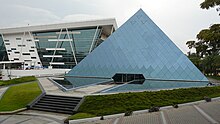
| State/Union Territory | All India Rank | GDP (Crore₹) | NSDP (Crore₹) |
|---|---|---|---|
| Tamil Nadu | 2 | 17,97,228 | 16,19,720 |
| Karnataka | 5 | 16,28,927 | 14,75,277 |
| Andhra Pradesh | 8 | 9,71,224 | 8,70,064 |
| Telangana | 9 | 9,57,207 | 8,71,374 |
| Kerala | 11 | 8,54,689 | 7,73,099 |
| Puducherry | 26 | 38,003 | 34,578 |
| South India | 62,47,278 | 56,44,113 |
| Economic and demographic indicators (2019–20)[132][249][247][248] | ||
|---|---|---|
| Parameter | South India | All India |
| Gross domestic product (GDP) | ₹62.5 trillion | ₹207.7 trillion |
| Net state domestic product (SDP) | ₹56.4 trillion | ₹186.4 trillion |
| Population below the poverty line | 15.4% | 26.1% |
| Urban population | 32.8% | 27.8% |
| Households with electricity | 98.9% | 88.2% |
| Literacy rate | 81.1% | 74% |
Agriculture
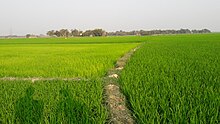
Agriculture is the primary occupation in South India with nearly 5.31 crore people engaged in agriculture and allied activities in 2021.[250] Rice is the staple food and major crop in the region.[251] South India is a major producer of spices with black pepper, cardamom, clove and nutmeg grown exclusively in the region.[252][253] Some of the main crops cultivated in South India include sugarcane, chilli, banana, cotton, turmeric, millets and pulses.[254][255] Other plantation crops include cashew, coffee, tea, rubber, betel, areca nut, coconut, bamboo and cocoa.[256] The region accounts for 92% of the coffee[240][257] and 85% of the natural rubber production in the country.[258]
Other major agricultural products include poultry and silk.[259][260] Being a peninsular region, aquaculture is a major contributor to the economy. As of 2017–18, the region produced 53.68 lakh tonnes fish contributing to nearly 43% of total fish production in India.[261] Like most of the Indian subcontinent, agriculture in the region is largely dependent on seasonal monsoons[262] and monsoon failure often leads to droughts forcing farmers into debt, selling livestock and sometimes into committing suicide.[263][264]
Information technology
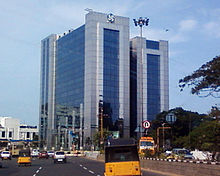
South India's urban centres are significant contributors to the Indian and global IT economy. Bengaluru, Chennai, Hyderabad, Coimbatore, Kochi and Thiruvananthapuram are amongst the major information technology (IT) hubs of India.[265][266][267][268][269] The presence of these hubs has spurred economic growth and attracted foreign investments and job seekers from other parts of the country.[270] Software exports from South India grossed over ₹640 billion (US$7.7 billion) in fiscal 2005–06.[271]
Manufacturing
Manufacturing is various states are governed by state owned industrial corporations like APIIC (Andhra Pradesh), KIDC (Karnataka), KSIDC (Kerala), TIDC (Tamil Nadu) apart from central government owned companies. The automotive industry in Chennai accounts for about 35% of India's overall automotive components and automobile output with Andhra Pradesh is emerging as another automobile manufacturing hub.[272][273] Coimbatore supplies two-thirds of India's requirements of motors and pumps, and is one of the largest exporters of wet grinders and auto components, as well as jewellery.[274] Another major industry is textiles[275] with the region being home to nearly 60% of the fiber textile mills in India.[276] State owned companies include Bharat Electronics (electrical components), Bharat Heavy Electricals Limited (power equipments) and HMT (machine tools).[277][278] Integral Coach Factory in Chennai, operated by Indian Railways is the oldest and largest producer of railway coaches and wagons.[279]
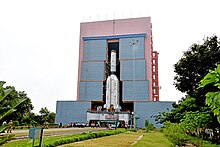
Space and Defense
Defense establishments include Hindustan Aeronautics Limited in Bangalore which manufactures fighter aircraft, helicopters and aircraft components.[280] DRDO which is India's premier defense agency operates various facilities in Chennai, Bangalore, Hyderabad and Mysuru in South India.[281]
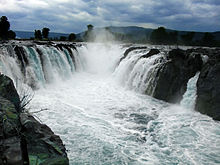
There are three Ordnance factories in Aruvankadu (Tamil Nadu), Tiruchirappalli and Medak.[282][283] AVANI, headquartered in Chennai manufactures Armoured fighting vehicles, Main battle tanks, tank engines and armored clothing for the use of the Indian Armed Forces.[284][285][286] Bharat Dynamics manufacturers of ammunitions and missile systems and is based in Hyderabad.[287]
ISRO is the premier Indian space agency primarily responsible for performing tasks related to space-based operations, space exploration, international space cooperation and the development of related technologies. It is headquartered in Bangalore.[288] It operates research facilities in Thiruvananthapuram and Tirupati, test facility at Mahendragiri, satellite development facilities at Bangalore, launch facilities at Sriharikota and Thiruvananthapuram, tracking facilities at Bangalore, Hyderabad and Hassan and Indian Institute of Space Science and Technology at Thiruvananthapuram.[289]
Tourism
Tourism contributes significantly to the GDP of the region, with four states – Tamil Nadu, Andhra Pradesh, Karnataka, and Telangana – among the top 10 states for tourist arrivals, accounting for more than 50% of domestic tourist visits.[290]
Tamil Nadu has the largest tourist inflow in India both domestic and international as of 2020.[291] In 2023, Kerala was listed at the 13th spot in The New York Times' annual list of places to visit and was the only tourist destination listed from India.[292] Kerala was named by TIME magazine in 2022 among the 50 extraordinary destinations to explore in its list of the World's Greatest Places.[293]
Culture and heritage
As defined by Ministry of Culture of the Government of India to promote and preserve the cultural heritage, most of the region falls under the purview of South Zone Cultural Center at Thanjavur.[294]
Clothing
South Indian women traditionally wear a sari, a garment that consists of a drape varying from 5 yards (4.6 m) to 9 yards (8.2 m) in length and 2 feet (0.61 m) to 4 feet (1.2 m) in breadth that is typically wrapped around the waist, with one end draped over the shoulder, baring the midriff, as according to Indian philosophy, the navel is considered as the source of life and creativity.[295][296] Ancient Tamil poetry such as the Silappadhikaram, describes women in exquisite drapery or sari.[297] Madisar is a typical style worn by Brahmin women from Tamil Nadu.[298] Women wear colourful silk sarees on special occasions such as marriages.[299] Kanchipuram silk sari is a type of silk sari made in the Kanchipuram region in Tamil Nadu and these saris are worn as bridal and special occasion saris by most women in South India. It has been recognized as a Geographical indication by the Government of India in 2005–2006.[300][301] Kovai Cora Cotton is a type of cotton saree made in the Coimbatore.[302][303]
The men wear a dhoti, a 4.5 metres (15 ft) long, white rectangular piece of non-stitched cloth often bordered in brightly coloured stripes. It is usually wrapped around the waist and the legs and knotted at the waist.[304] A colourful lungi with typical batik patterns is the most common form of male attire in the countryside.[305]
People in urban areas generally wear tailored clothing, and western dress is popular. Western-style school uniforms are worn by both boys and girls in schools, even in rural areas.[305] Calico, a plain-woven textile made from unbleached, and often not fully processed, cotton, was originated at Calicut (Kozhikode), from which the name of the textile came, in South India, now Kerala, during the 11th century,[306] where the cloth was known as Chaliyan.[307] The raw fabric was dyed and printed in bright hues, and calico prints later became popular in the Europe.[308]
Cuisine
Rice is the staple food in South Indian meals.[309] Coconut and spices are used extensively in South Indian cuisine. The region has a rich cuisine involving both traditional non-vegetarian and vegetarian dishes comprising rice, legumes, and lentils. Its distinct aroma and flavour is achieved by the blending of flavourings and spices, including curry leaves, mustard seeds, coriander, ginger, garlic, chili, pepper, cinnamon, cloves, green cardamom, cumin, nutmeg, coconut, and rosewater.[310][311]
The traditional way of eating a meal involves being seated on the floor, having the food served on a banana leaf,[312] and using clean fingers of the right hand to take the food into the mouth.[313] After the meal, the fingers are washed; the easily degradable banana leaf is discarded or becomes fodder for cattle.[314] Eating on banana leaves is a custom thousands of years old, imparts a unique flavor to the food, and is considered healthy.[315]
Idli, dosa, uthappam, pesarattu, appam, pongal, and paniyaram are popular breakfast dishes.[316][317] Rice is generally served with sambar and rasam for lunch. Tamil cuisine includes a typical virundhu for lunch with poriyal, kootu and kuzhambu.[318] Particular dishes include sevai, paniyaram, parotta and opputtu.[319] Kerala cuisine includes dishes like appam idiyappam, puttu, and pathiri and a full-course vegetarian meal is known as sadya.[320] Andhra cuisine is characterized by pickles and spicy curries with popular dishes including Ulava charu, Bobbatlu, Pootharekulu and Gongura.[321] Chettinad cuisine is famous for its non-vegetarian items, and Hyderabadi cuisine is popular for its biryani.[322] Udupi Cuisine, which originates from Udupi located in the Coastal Kanara region of Karnataka is famous for its vegetarian dishes and Neer dosa, Ragi mudde, Maddur vada, Obbattu, Bisi Bele Bath and Dharwad pedha are some of the popular cuisines of Karnataka.[323] Fish and sea food form an integral component of the diet along the coast.[324]
Music and dance
The traditional music of South India is known as Carnatic music, which includes rhythmic and structured music by composers such as Purandara Dasa, Kanaka Dasa, Tyagayya, Annamacharya, Baktha Ramadasu, Muthuswami Dikshitar, Shyama Shastri, Kshetrayya, Mysore Vasudevachar, and Swathi Thirunal.[325] Nadaswaram, a reed instrument that is often accompanied by the thavil, a type of drum instrument are the major musical instruments used in temples and weddings.[326]
South India is home to several distinct dance forms with major being Bharatanatyam, Kuchipudi, Kathakali, Mohiniaattam and Yakshagana.[327][328] Other regional folk dances include Andhra Natyam, Karakattam, Kavadi, Kerala Natanam, Koodiyattam, Margamkali, Oppana, Ottamthullal, Oyilattam, Puravaiattam and Theyyam.[329][330][331][332] The dance, clothing, and sculptures of South India exemplify the beauty of the body and motherhood.[333]
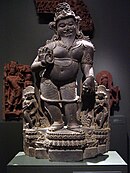
Literature
South India has an independent literary tradition dating back over 2500 years. The first known literature of South India is the poetic Sangam literature, which was written in Tamil 2500 to 2100 years ago. Tamil literature was composed in three successive poetic assemblies known as Tamil Sangams, the earliest of which, according to ancient tradition, were held on a now vanished continent far to the south of India.[334] This Tamil literature includes the oldest grammatical treatise, Tholkappiyam, and the epics Silappatikaram and Manimekalai.[335]
References to Kannada literature appear from the fourth century CE.[336][337] Telugu literature adopted a form of Prakrit which in course of development became the immediate ancestor of Telugu.[338] Distinct Malayalam literature came later in the 13th century.[339]
Architecture

South India has two distinct styles of rock architecture, the Dravidian style of Tamil Nadu, Andhra Pradesh and the Vesara style of Karnataka, Telangana.[340] The Architecture of Kerala is a unique architecture that emerged from the Dravidian architecture in the southwestern part of India.[341]
In Dravidian architecture, the temples considered of porches or Mantapas preceding the door leading to the sanctum, Gate-pyramids or Gopurams in quadrangular enclosures that surround the temple and Pillared halls used for many purposes and are the invariable accompaniments of these temples. Besides these, a South Indian temple usually has a tank called the Kalyani or Pushkarni.[342] The Gopuram is a monumental tower, usually ornate at the entrance of the temple forms a prominent feature of Koils and Hindu temples of the Dravidian style.[343] They are topped by the kalasam, a bulbous stone finial and function as gateways through the walls that surround the temple complex.[344] The gopuram's origins can be traced back to the Pallavas who built the group of monuments in Mahabalipuram and Kanchipuram.[345] The Cholas later expanded the same and by the Pandya rule in twelfth century, these gateways became a dominant feature of a temple's outer appearance.[346][347] Vimanam are similar structures built over the garbhagriha or inner sanctum of the temple but are usually smaller than the gopurams in the Dravidian architecture with a few exceptions including the Brihadisvara Temple in Thanjavur.[348][349]
Vesara style of architecture originated during the reign of Chalukyas and later adopted by Western Chalukyas and Hoysalas.[350] The later Vijayanagara architecture incorporated the features of both Dravidian and Vesara styles.[351] The temples at Mahabalipuram,[345] Thanjavur, Gangaikonda Cholapuram and Darasuram,[352] Hampi[353] and Pattadakal[354] are declared UNESCO World Heritage sites.
Visual arts

Films done in regional languages are prevalent in South India, with several regional cinemas being recognized: Kannada cinema (Karnataka), Malayalam cinema (Kerala), Tamil cinema (Tamil Nadu), and Telugu cinema (Andhra Pradesh and Telangana). The first silent film in South India, Keechaka Vadham, was made by R. Nataraja Mudaliar in 1916.[355] Mudaliar also established Madras's first film studio.[356] The first Tamil talkie, Kalidas, was released on 31 October 1931, barely seven months after India's first talking picture, Alam Ara.[357]
Swamikannu Vincent built the first cinema studio of South India, at Coimbatore, introducing the "tent cinema", which he first established in Madras and which was known as "Edison's Grand Cinemamegaphone".[358] Filmmakers K. N. T. Sastry and B. Narsing Rao in Telugu cinema; K Balachandar, Balu Mahendra, Bharathiraaja, and Mani Ratnam in Tamil cinema; Adoor Gopalakrishnan, Shaji N. Karun, John Abraham, and G. Aravindan in Malayalam cinema; and Girish Kasaravalli, Girish Karnad and P. Sheshadri in Kannada cinema produced realistic cinema in parallel with each other throughout the 1970s.[359]
South Indian cinema has also had an influence on politics of Tamil Nadu.[360] Prominent film personalities such as C N Annadurai, M G Ramachandran, M Karunanidhi, N. T. Rama Rao, and Jayalalithaa have become chief ministers of South Indian states.[361] As of 2014, South Indian film industries contribute to 53% of the total films produced in India.[362]
| Feature films certified by the Central Board of Film Certification (2019)[363] | |
|---|---|
| Language | No. of films |
| Telugu | 281 |
| Tamil | 254 |
| Malayalam | 219 |
| Kannada | 336 |
| Tulu | 16 |
| Konkani | 10 |
| Total | 1116 |
Utility services
Health
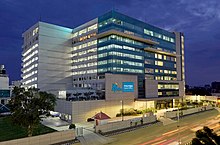
All South Indian states rank in the top 10 in institutional delivery in India[364] and life expectancy.[137] South India also rates higher in maternal health and reduction infant and child mortality.[143] Chennai attracts about 45 percent of health tourists and is known as India's health capital.[365]
The number of public facilities in South India as of 2018:
| State | Public facilities | Public beds[366] | ||||
|---|---|---|---|---|---|---|
| Primary Centers | Community Centers | Sub/Divisional Hospitals | District Hospitals | Total | ||
| Andhra Pradesh | 1,417 | 198 | 31 | 20 | 1,666 | 60,799 |
| Karnataka | 2,547 | 207 | 147 | 42 | 2,943 | 56,333 |
| Kerala | 933 | 229 | 82 | 53 | 1,297 | 39,511 |
| Lakshadweep | 4 | 3 | 2 | 1 | 10 | 250 |
| Puducherry | 40 | 4 | 5 | 4 | 53 | 4,462 |
| Tamil Nadu | 1,854 | 385 | 310 | 32 | 2,581 | 72,616 |
| Telangana | 788 | 82 | 47 | 15 | 932 | 17,358 |
| Total | 7,583 | 1,108 | 624 | 167 | 9,482 | 251,509 |
The number of Government Hospitals and Beds in Rural & Urban Areas as of 2017:[366]
| State | Rural | Urban | ||
|---|---|---|---|---|
| Hospitals | Beds | Hospitals | Beds | |
| Andhra Pradesh | 193 | 6,480 | 65 | 16,658 |
| Karnataka | 2,471 | 21,072 | 374 | 49,093 |
| Kerala | 981 | 16,865 | 299 | 21,139 |
| Lakshadweep | 9 | 300 | 0 | 0 |
| Puducherry | 3 | 96 | 11 | 3,473 |
| Tamil Nadu | 692 | 40,179 | 525 | 37,353 |
| Telangana | 802 | 7,668 | 61 | 13,315 |
| Total | 5,151 | 92,780 | 1,335 | 141,031 |
Education
As per the 2011 census, the average literacy rate in South India is approximately 80%, considerably higher than the Indian national average of 74%, with Kerala having the highest literacy rate of 93.91%.[116] South India is home to some of the nation's largest and most prominent public and private institutions of higher education.
The table below is correct as of 26 November 2022[update].
| State | Central universities |
State universities |
Deemed universities |
Private universities |
Total |
|---|---|---|---|---|---|
| Andhra Pradesh (list) | 3 | 27 | 4 | 6 | 40 |
| Karnataka (list) | 1 | 34 | 14 | 25 | 74 |
| Kerala (list) | 1 | 15 | 3 | 0 | 19 |
| Puducherry (list) | 1 | 1 | 1 | 0 | 3 |
| Tamil Nadu (list) | 2 | 22 | 28 | 4 | 56 |
| Telangana (list) | 3 | 17 | 4 | 5 | 29 |
| Total | 11 | 116 | 54 | 40 | 221 |
Following are the Institutes of National Importance present across the region.[367]
Sports
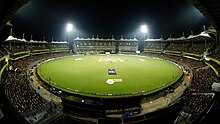
Cricket is the most popular sport in South India.[368] The region has five current international cricket venues: M. A. Chidambaram Stadium in Chennai, M. Chinnaswamy Stadium in Bangalore, Dr. Y. S. Rajasekhara Reddy International Cricket Stadium in Vishakapatnam, Rajiv Gandhi International Cricket Stadium in Hyderabad and Greenfield International Stadium in Thiruvananthapuram. Six more defunct venues have also hosted international matches in the past.[369][370] Tennis ball cricket is played throughout the region.[371] Indian Premier League is the premium T20 cricket competition which has three teams from the region namely Chennai Super Kings, Royal Challengers Bangalore and Sunrisers Hyderabad. Chennai Super Kings is the most successful franchise in IPL.[372]

Football is also popular with the Indian Super League being the major club competition. There are four teams from the region:Bengaluru FC, Chennaiyin FC, Hyderabad FC and Kerala Blasters FC. The Southern Derby or Southern Rivalry, is the name given to a derby contested by any two of the three professional football clubs Bengaluru, Chennaiyin and Kerala Blasters.[373][374][375] Santosh Trophy is a football competition amongst states organized by the Indian Football Association.[376][377] As of 2022, South Indian teams have won 17 championships.[378]
Kabaddi is a contact sport which is the state game of all the states in South India.[379] It is played across the region. Pro Kabaddi League is the most popular region based franchise tournament and has three teams representing the region: Bengaluru Bulls, Tamil Thalaivas and Telugu Titans.[380][381]
Chess is a popular board game which originated as Sathurangam in the seventh century A.D.[382] Traditional games like Pallanguzhi,[383] Uriyadi,[384] Gillidanda,[385] Dhaayam[386] are played across the region. Jallikattu,[387] Rekla[388] and Kambala[389] are traditional sporting events involving bulls. Traditional martial arts include Silambattam,[390] Gatta gusthi,[391] Adimurai[392] and Kalari.[393] Vallam kali is a boat race organized in Kerala.[394]
See also
References
- ^ Indian languages (PDF) (Report). Ministry of Education, Government of India. Archived (PDF) from the original on 28 May 2023. Retrieved 30 August 2023.
- ^ "Census 2011, States". Government of India. Archived from the original on 28 November 2018. Retrieved 9 September 2020.
- ^ Census 2011 (Final Data) – Demographic details, Literate Population (Total, Rural & Urban) (PDF) (Report). Planning Commission, Government of India. Archived from the original (PDF) on 27 January 2018. Retrieved 3 October 2018.
- ^ Word Histories and Mysteries: From Abracadabra to Zeus. Houghton Mifflin Harcourt. 2004. p. 216. ISBN 978-0547350271. OCLC 55746553.
- ^ Yule, Henry; Burnell, A. C. (13 June 2013). Hobson-Jobson:The Definitive Glossary of British India. London: Oxford. p. 199. ISBN 978-0-1916-4583-9.
- ^ "Origins of the word 'Carnatic' in the Hobson Jobson Dictionary". Chicago: University of Chicago. Archived from the original on 14 July 2012. Retrieved 15 September 2006.
- ^ Agarwal, D.P (2006). Urban Origins in India (PDF). Uppsala University. p. 3. Archived from the original (PDF) on 30 May 2023. Retrieved 30 August 2023.
- ^ Schoff, Wilfred (1912). The Periplus of the Erythraean Sea: Travel And Trade In The Indian Ocean By A Merchant Of The First Century. South Asia Books. ISBN 978-8-1215-0699-1.
- ^ J. Innes, Miller (1998) [1969]. The Spice Trade of The Roman Empire: 29 B.C. to A.D. 641. Oxford University Press. ISBN 978-0-1981-4264-5.
- ^ Landstrom, Bjorn (1964). The Quest for India. Allwin and Unwin. ISBN 978-0-0491-0016-9.
- ^ Elisseeff, Vadime (2001). The Silk Roads: Highways of Culture and Commerce. UNESCO Publishing / Berghahn Books. ISBN 978-9-2310-3652-1.
- ^ Sastri, Nilakanta (1976). A History of South India from Prehistoric Times to the Fall of Vijayanagar. Oxford University Press. pp. 7, 69, 179, 199, 214, 239. ISBN 978-0-1956-0686-7.
- ^ Rajayyan, K. (1974). Rise and Fall of the Poligars of Tamilnadu. University of Madras. p. 2.
- ^ Hibbert, Christopher (1 March 2000). Great Mutiny: India 1857. Penguin. p. 221. ISBN 978-0-1400-4752-3.
- ^ Indian National Evolution: A Brief Survey of the Origin and Progress of the Indian National Congress and the Growth of Indian Nationalism. Cornell University Press. 22 September 2009. p. 59. ISBN 978-1-1124-5184-3.
- ^ "Article 1". Constitution of India. Ministry of Law and Justice, Government of India. Archived from the original on 2 April 2012. Retrieved 31 December 2015.
- ^ Taylor, Richard Warren (1982). Religion and Society: The First Twenty-five Years, 1953–1978. Christian Literature Society. p. 242. OCLC 9007066.
- ^ Thapar, Romesh (1978). Change and Conflict in India. Macmillan. p. 75. ISBN 978-0-8364-0222-3.
- ^ Rao, C Rajeswara (1973). Defeat Separatist Conspiracy in Andhra. Communist Party of India. p. 28. OCLC 814926.
- ^ a b c Reorganisation of states (PDF) (Report). Economic Weekly. 15 October 1955. Archived (PDF) from the original on 18 February 2016. Retrieved 31 December 2015.
- ^ "Seventh Amendment". Government of India. Archived from the original on 22 August 2023. Retrieved 19 August 2023.
- ^ Background information on state of Tamil Nadu (Report). Ministry of Labour and Employment, Government of India. Archived from the original on 29 September 2023. Retrieved 16 September 2023.
- ^ a b c States Reorganisation Act, 1956 (PDF) (Report). High Court of Tripura. Archived (PDF) from the original on 29 September 2023. Retrieved 16 September 2023.
- ^ "Mysore, an Indian State, Is Renamed as Karnataka". The New York Times. 30 July 1972. Archived from the original on 29 September 2023. Retrieved 24 July 2023.
- ^ The Andhra Pradesh Reorganisation Act, 2014 (PDF) (Report). Ministry of law and Justice, Government of India. Archived from the original (PDF) on 8 January 2016. Retrieved 3 March 2014.
- ^ "Telangana bill passed by upper house". Times of India. 20 February 2014. Archived from the original on 20 February 2014. Retrieved 20 March 2016.
- ^ Patrick, David (1907). Chambers's Concise Gazetteer of the World. W.& R.Chambers. p. 353.
- ^ Fisher, William (1995). Toward Sustainable Development? Struggling Over India's Narmada River. New York: M. E. Sharpe. p. 51. ISBN 978-1-5632-4525-1.
- ^ "Adam's bridge". Encyclopædia Britannica. 2007. Archived from the original on 13 January 2008. Retrieved 1 January 2016.
- ^ "Map of Sri Lanka with Palk Strait and Palk Bay" (PDF). UN. Archived (PDF) from the original on 17 January 2016. Retrieved 1 January 2016.
- ^ "Kanyakumari alias Cape Comorin". Lonely Planet. Archived from the original on 3 November 2019. Retrieved 1 January 2016.
- ^ Myers, Norman; Mittermeier, Russell A.; Mittermeier, Cristina G.; Da Fonseca, Gustavo A. B.; Kent, Jennifer (2000). "Biodiversity hotspots for conservation priorities". Nature. 403 (6772): 853–858. Bibcode:2000Natur.403..853M. doi:10.1038/35002501. PMID 10706275. S2CID 4414279. Archived from the original on 9 October 2013. Retrieved 16 November 2013.
- ^ Playne, Somerset; Bond, J. W; Wright, Arnold (2004). Southern India: its history, people, commerce, and industrial resources. Asian Educational Service. p. 417. OCLC 58540809. Archived from the original on 31 March 2024. Retrieved 30 August 2023.
- ^ "Eparchaean Unconformity, Tirumala Ghat section". Geological Survey of India. Archived from the original on 19 April 2013. Retrieved 20 September 2009.
- ^ DellaSala, Dominick A.; Goldstei, Michael I. (2020). Encyclopedia of the World's Biomes. Amsterdam: Elsevier Science. p. 546. ISBN 978-0-1281-6097-8.
- ^ Eagan, J. S. C (1916). The Nilgiri Guide And Directory. Chennai: S.P.C.K. Press. p. 30. ISBN 978-1-1494-8220-9.
- ^ Dr. Jadoan, Atar Singh (September 2001). Military Geography of South-East Asia. India: Anmol Publications. ISBN 978-8-1261-1008-7.
- ^ "The Deccan Peninsula". Sanctuary Asia. 5 January 2001. Archived from the original on 17 October 2006.
- ^ "Eastern Deccan Plateau Moist Forests". World Wildlife Fund. Archived from the original on 18 January 2008. Retrieved 5 January 2007.
- ^ Chu, Jennifer (11 December 2014). "What really killed the dinosaurs?". MIT. Archived from the original on 26 December 2014. Retrieved 28 August 2023.
- ^ "Deccan Plateau". Britannica. Archived from the original on 1 May 2015. Retrieved 1 January 2016.
- ^ Bose, Mihir (1977). Indian Journal of Earth Sciences. Indian Journal of Earth Sciences. p. 21.
- ^ J. Sacratees; R. Karthigarani (2008). Environment impact assessment. APH Publishing. p. 10. ISBN 978-8-1313-0407-5.
- ^ Limits of Oceans and Seas, 3rd edition (PDF) (Report). International Hydrographic Organization. 1953. p. 21. Archived from the original (PDF) on 8 October 2011. Retrieved 28 December 2020.
- ^ Jenkins, Martin (1988). Coral Reefs of the World: Indian Ocean, Red Sea and Gulf. United Nations Environment Programme. p. 84.
- ^ Subba Rao, Nune (1989). Fisheries Development and Management in India, 1785-1986. Northern Book Centre. p. 37. ISBN 978-8-1851-1960-1.
- ^ McKnight, Tom L; Hess, Darrel (2000). "Climate Zones and Types: The Köppen System". Physical Geography: A Landscape Appreciation. Upper Saddle River, NJ: Prentice Hall. pp. 205–211. ISBN 978-0-1302-0263-5.
- ^ Chouhan, T. S. (1992). Desertification in the World and Its Control. Scientific Publishers. ISBN 978-8-1723-3043-9.
- ^ "India's heatwave tragedy". BBC News. 17 May 2002. Archived from the original on 31 March 2024. Retrieved 20 March 2016.
- ^ Caviedes, C. N. (18 September 2001). El Niño in History: Storming Through the Ages (1st ed.). University Press of Florida. ISBN 978-0-8130-2099-0.
- ^ World Wildlife Fund, ed. (2001). "South Deccan Plateau dry deciduous forests". WildWorld Ecoregion Profile. National Geographic Society. Archived from the original on 8 March 2010. Retrieved 5 January 2005.
- ^ "South Deccan Plateau dry deciduous forests". Terrestrial Ecoregions. World Wildlife Fund. Retrieved 5 January 2005.
- ^ "North East Monsoon". IMD. Archived from the original on 29 December 2015. Retrieved 1 January 2016.
- ^ Rohli, Robert V.; Vega, Anthony J. (2007). Climatology. Jones & Bartlett Publishers. p. 204. ISBN 978-0-7637-3828-0.
- ^ Annual frequency of cyclonic disturbances over the Bay of Bengal (BOB), Arabian Sea (AS) and land surface of India (PDF) (Report). India Meteorological Department. Archived from the original (PDF) on 5 August 2011. Retrieved 1 January 2016.
- ^ "hurricane". Oxford dictionary. Archived from the original on 2 March 2014. Retrieved 1 October 2014.
- ^ "The only difference between a hurricane, a cyclone, and a typhoon is the location where the storm occurs". NOAA. Archived from the original on 11 November 2019. Retrieved 1 October 2014.
- ^ "Indo-Malayan Terrestrial Ecoregions". National Geographic. Archived from the original on 21 March 2001. Retrieved 15 April 2006.
- ^ "Western Ghats". UNESCO. Archived from the original on 18 January 2013. Retrieved 21 February 2014.
- ^ Lewis, Clara (3 July 2007). "39 sites in Western Ghats get world heritage status". The Times of India. Archived from the original on 7 July 2012. Retrieved 21 February 2014.
- ^ Biosphere Reserves in India (PDF) (Report). Ministry of Environment, Forest and Climate Change. 2019. Archived (PDF) from the original on 5 February 2020. Retrieved 5 February 2020.
- ^ Sacratees, J.; Karthigarani, R. (2008). Environment impact assessment. APH Publishing. p. 10. ISBN 978-8-1313-0407-5.
- ^ "Conservation and Sustainable-use of the Gulf of Mannar Biosphere Reserve's Coastal Biodiversity". New York. 1994. Archived from the original (doc) on 16 June 2007.
- ^ Baker, H.R.; Inglis, Chas. M. (1930). The birds of southern India, including Madras, Malabar, Travancore, Cochin, Coorg and Mysore. Chennai: Superintendent, Government Press.
- ^ Grimmett, Richard; Inskipp, Tim (30 November 2005). Birds of Southern India. A&C Black.
- ^ "India's tiger population rises". Deccan Chronicle. 15 January 2015. Archived from the original on 3 March 2016. Retrieved 19 March 2016.
- ^ Elephant Census 2005 (PDF) (Report). Ministry of Environment and Forests, Government of India. 2007. Archived from the original (PDF) on 12 March 2012. Retrieved 23 February 2003.
- ^ Panwar, H. S. (1987). Project Tiger: The reserves, the tigers, and their future. Noyes Publications, Park Ridge, N.J. pp. 110–117. ISBN 978-0-8155-1133-5. Archived from the original on 31 March 2024. Retrieved 21 November 2020.
- ^ "Project Elephant Status". Times of India. 2 February 2009. Archived from the original on 2 August 2014. Retrieved 24 February 2009.
- ^ Sukumar, R (1993). The Asian Elephant: Ecology and Management. Cambridge University Press. ISBN 978-0-5214-3758-5. Archived from the original on 17 March 2024. Retrieved 13 June 2020.
- ^ "Grizzled Squirrel Wildlife Sanctuary". Wild Biodiversity. TamilNadu Forest Department. 2007. Archived from the original on 9 April 2009. Retrieved 24 February 2009.
- ^ Singh, M.; Lindburg, D.G.; Udhayan, A.; Kumar, M.A.; Kumara, H.N. (1999). Status survey of slender loris Loris tardigradus lydekkerianus. Oryx. pp. 31–37.
- ^ Kottur, Samad (2012). Daroji-an ecological destination. Drongo. ISBN 978-9-3508-7269-7.
- ^ "Nilgiri tahr population over 3,000: WWF-India". The Hindu. 3 October 2015. Archived from the original on 8 February 2016. Retrieved 19 March 2016.
- ^ Malviya, M.; Srivastav, A.; Nigam, P.; Tyagi, P.C. (2011). Indian National Studbook of Nilgiri Langur (Trachypithecus johnii) (PDF) (Report). Wildlife Institute of India, Dehradun and Central Zoo Authority, New Delhi. Archived (PDF) from the original on 4 March 2016. Retrieved 19 March 2016.
- ^ Singh, M.; Kumar, A.; Kumara, H.N. (2020). "Macaca silenus". IUCN Red List of Threatened Species. 2020: e.T12559A17951402. doi:10.2305/IUCN.UK.2020-2.RLTS.T12559A17951402.en. Retrieved 12 November 2021.
- ^ Stein, A.B.; Athreya, V.; Gerngross, P.; Balme, G.; Henschel, P.; Karanth, U.; Miquelle, D.; Rostro-Garcia, S.; Kamler, J.F.; Laguardia, A.; Khorozyan, I.; Ghoddousi, A. (2020). "Panthera pardus". IUCN Red List of Threatened Species. 2020: e.T15954A163991139. doi:10.2305/IUCN.UK.2020-1.RLTS.T15954A163991139.en. Retrieved 12 November 2021.
- ^ "State Symbols of India". Ministry of Environment, Forests & Climate Change, Government of India. Archived from the original on 22 September 2023. Retrieved 30 August 2023.
- ^ "Symbols of AP". Government of Andhra Pradesh. Archived from the original on 31 August 2023. Retrieved 15 August 2023.
- ^ "Symbols of Karnataka". Government of Karnataka. Archived from the original on 10 October 2013. Retrieved 15 October 2013.
- ^ "Symbols of Kerala". Government of Kerala. Archived from the original on 18 October 2013. Retrieved 17 October 2013.
- ^ "Symbols of Lakshadweep" (PDF). Government of Lakshadweep. Archived from the original (PDF) on 17 October 2013. Retrieved 17 October 2013.
- ^ "Puducherry comes out with list of State symbols". The Hindu. 21 April 2007. Archived from the original on 31 October 2007. Retrieved 10 February 2014.
- ^ "Symbols of Tamil Nadu". Government of Tamil Nadu. Archived from the original on 31 March 2024. Retrieved 12 August 2023.
- ^ "Telangana symbols". Government of Telangana. Archived from the original on 19 May 2017. Retrieved 2 January 2015.
- ^ a b Ralhan, O.P. (2002). Encyclopedia of Political Parties. Print House. pp. 180–199. ISBN 978-8-1748-8287-5.
- ^ Irschick, Eugene F. (1969). Political and Social Conflict in South India; The non-Brahmin movement and Tamil Separatism, 1916–1929 (PDF). University of California Press. OCLC 249254802. Archived from the original (PDF) on 4 March 2016. Retrieved 20 March 2016.
- ^ Wyatt, A.K.J. (2002). "New Alignments in South Indian Politics: The 2001 Assembly Elections in Tamil Nadu". Asian Survey. 42 (5). University of California Press: 733–753. doi:10.1525/as.2002.42.5.733. hdl:1983/1811. Archived from the original on 12 February 2020. Retrieved 20 March 2020.
- ^ Hasan, Zoya (2 February 2003). "The democratisation of politics". The Hindu. Archived from the original on 7 March 2008. Retrieved 19 April 2008.
- ^ Gopal, Madan (1990). K.S. Gautam (ed.). India through the ages. Publication Division, Ministry of Information and Broadcasting, Government of India. p. 164. ASIN B003DXXMC4.
- ^ "Telugu Desam Party turns 29, NT Rama Rao remembered". DNA India. 29 March 2010. Archived from the original on 1 April 2010. Retrieved 31 May 2010.
- ^ Törnquist, Olle (1991). "Communists and democracy: Two Indian cases and one debate" (PDF). Bulletin of Concerned Asian Scholars. 23 (2). Committee of Concerned Asian Scholars: 63–76. doi:10.1080/14672715.1991.10413152. ISSN 0007-4810. Archived from the original (PDF) on 11 August 2011. Retrieved 1 January 2016.
The first democratically elected communist-led government in India actually came to power in 1957 in the southwest-Indian state of Kerala
- ^ Singh, Sarina; Karafin, Amy; Mahapatra, Anirban (1 September 2009). South India. Lonely Planet. ISBN 978-1-7417-9155-6.
- ^ Price, Pamela. Ideological Elements in Political Instability in Karnataka (PDF) (Report). University of Oslo. Archived from the original (PDF) on 25 May 2006.
- ^ Guha, Ramachandra (15 April 2006). "Why Amartya Sen should become the next president of India". The Telegraph. Archived from the original on 11 September 2012. Retrieved 30 November 2008.
- ^ "Giri, Shri Varahagiri Venkata". Vice President's Secretariat. Archived from the original on 10 February 2009. Retrieved 30 November 2008.
- ^ Bhargava, G.S. (29 July 2007). "Making of the President – Congress chief selects PM as well as President". The Tribune. India. Archived from the original on 17 April 2019. Retrieved 6 January 2009.
- ^ Hazarika, Sanjoy (17 July 1987). "India's Mild New President: Ramaswamy Venkataraman". The New York Times. Archived from the original on 12 August 2023. Retrieved 6 January 2009.
- ^ "Narayanan, Shri K, R". Vice President's Secretariat. Archived from the original on 10 February 2009. Retrieved 6 December 2008.
- ^ Ramana, M. V.; Reddy, C., Rammanohar (2003). Prisoners of the Nuclear Dream. New Delhi: Orient Blackswan. p. 169. ISBN 978-8-1250-2477-4.
- ^ Aiyar, S.A. (26 June 2011). "Unsung hero of the India story". Times of India. Archived from the original on 21 January 2014. Retrieved 30 August 2023.
Twenty years ago, Narasimha Rao became Prime Minister and initiated economic reforms that transformed India
- ^ "Zonal council". Government of India. Archived from the original on 4 December 2023. Retrieved 1 August 2023.
- ^ Present Composition Of The Southern Zonal Council (PDF) (Report). Government of India. Archived (PDF) from the original on 17 February 2017. Retrieved 27 December 2017.
- ^ "States and Union Territories". Government of India. Archived from the original on 5 February 2022. Retrieved 17 August 2023.
- ^ "Union Territories of India". National Portal of India. Archived from the original on 26 November 2012. Retrieved 12 January 2016.
- ^ "Constitution of India". Ministry of Law and Justice, Government of India. Archived from the original on 25 March 2016. Retrieved 20 March 2016.
- ^ Basu, Durga Das (1960). Introduction to the Constitution of India. LexisNexis Butterworths. pp. 241, 245. ISBN 978-8-1803-8559-9.
- ^ Statement showing the Nomenclature and Number of Sub-Districts in States/UTs (Report). Office of The Registrar General & Census Commissioner, India, New Delhi. Archived from the original on 20 March 2016. Retrieved 19 March 2016.
- ^ a b c "State and local governments of India". Britannica. Archived from the original on 29 January 2016. Retrieved 12 January 2016.
- ^ a b "ISO Online Browsing Platform". ISO. Archived from the original on 17 June 2016. Retrieved 4 November 2014.
- ^ a b "Code List: 3229". UN/EDIFACT. GEFEG. Archived from the original on 25 December 2018. Retrieved 25 December 2012.
- ^ Demographics of Andhra Pradesh (Report). Government of Andhra Pradesh. Archived from the original on 5 December 2022. Retrieved 20 March 2023.
- ^ Telangana State Profile (Report). Government of Telangana. Archived from the original on 14 February 2015. Retrieved 11 June 2014.
- ^ a b c d e f "Area of Indian states". World Atlas. 10 July 2018. Archived from the original on 4 April 2020. Retrieved 24 March 2020.
- ^ a b Report of the Commissioner for linguistic minorities: 50th report (July 2012 to June 2013) (PDF) (Report). Commissioner for Linguistic Minorities, Ministry of Minority Affairs, Government of India. Archived from the original (PDF) on 8 July 2016. Retrieved 14 January 2015.
- ^ a b c d Literacy in South India (PDF) (Report). Government of Indiaformat=PDF. p. 14. Archived (PDF) from the original on 6 July 2015. Retrieved 24 March 2020.
- ^ a b Urban Population in South India (by percent) (PDF) (Report). Ministry of Housing and Urban Affairs, Government of India. p. 36. Archived (PDF) from the original on 26 March 2020. Retrieved 24 March 2020.
- ^ "Bifurcated into Telangana State and residual Andhra Pradesh State". Times of India. 2 June 2014. Archived from the original on 17 September 2018. Retrieved 20 March 2016.
- ^ The Gazette of India : The Andhra Pradesh Reorganization Act, 2014 Sub-section (PDF) (Report). 4 March 2014. Archived (PDF) from the original on 27 March 2014. Retrieved 23 April 2014.
- ^ Bhattacharya, Sanchari (1 June 2014). "Andhra Pradesh Minus Telangana: 10 Facts". NDTV. Archived from the original on 16 October 2014. Retrieved 20 March 2016.
- ^ a b "Lok Sabha Introduction". National Informatics Centre, Government of India. Archived from the original on 1 December 2008. Retrieved 22 September 2008.
- ^ a b "Rajya Sabha". Parliament of India. Archived from the original on 24 July 2013. Retrieved 8 December 2012.
- ^ a b "State/UT wise Seats in the Assembly and their Reservation Status". Election Commission of India. Archived from the original on 11 January 2012. Retrieved 8 December 2012.
- ^ Thorpeand, Showick (2015). "Chapter 3". The Pearson Concise General Knowledge Manual 2016. Pearson Education India. p. 17. ISBN 978-9-3325-5884-7.
- ^ Espenshade, TJ; Guzman, JC; Westoff, CF (2003). "The surprising global variation in replacement fertility". Population Research and Policy Review. 22 (5/6): 580. doi:10.1023/B:POPU.0000020882.29684.8e. S2CID 10798893.
- ^ Maternal & Child Mortality and Total Fertility Rates (PDF) (Report). India: Office of Registrar General. 7 July 2011. Archived (PDF) from the original on 28 July 2013. Retrieved 3 December 2013.
- ^ Ishtiaq, M. (1999). Language Shifts Among the Scheduled Tribes in India: A Geographical Study. Delhi: Motilal Banarsidass. pp. 26–27. ISBN 978-8-1208-1617-6. Retrieved 7 September 2012.
- ^ Comparative Speaker's Strength of Scheduled Languages – 1971, 1981, 1991 and 2001 (Report). Census of India. 1991. Archived from the original on 11 April 2009.
- ^ Distribution of workers by category of workers, Census 2011 (Report). Government of India. Archived from the original on 31 March 2016. Retrieved 20 March 2016.
- ^ Houselisting and Housing, Census 2011 (Report). Government of India. Archived from the original on 22 March 2016. Retrieved 20 March 2016.
- ^ Households access to safe drinking water (Report). Government of India. 2011. Archived from the original on 6 August 2020. Retrieved 21 April 2014.
- ^ a b "Also A Head For Numbers". Outlook. 16 July 2007. Archived from the original on 2 May 2013. Retrieved 22 July 2015.
- ^ Guha, Ramachandra (22 July 2015). "The Better Half". Outlook. Archived from the original on 20 March 2016. Retrieved 20 March 2016.
- ^ Antony, G.M.; Laxmaiah, A. (20 April 2015). "Human development, poverty, health & nutrition situation in India" (PDF). The Indian Journal of Medical Research. 128 (2). Council of Social Development, Southern Regional Centre & Division of Community Studies National Institute of Nutrition (ICMR): 198–205. PMID 19001685. Archived from the original (PDF) on 8 August 2021. Retrieved 22 July 2015.
- ^ Vital statistics report 2012 (PDF) (Report). Registrar General & Census Commissioner, Ministry of Home Affairs, Government of India. 19 April 2014. Archived (PDF) from the original on 22 April 2014. Retrieved 19 April 2014.
- ^ Economic Freedom of the States of India: 2013 (PDF) (Report). Cato Institute. 2013. p. 24. Archived (PDF) from the original on 29 April 2014. Retrieved 29 April 2014.
- ^ a b Inequality-Adjusted Human Development Index for India's States 2011 (PDF) (Report). United Nations Development Programme. Archived from the original (PDF) on 1 March 2013. Retrieved 13 February 2013.
- ^ Access to safe drinking water in households in India (PDF) (Report). Government of India. Archived from the original (PDF) on 6 August 2013. Retrieved 21 April 2014.
- ^ Houses and household amenities and assets (PDF) (Report). Government of India. Archived from the original (PDF) on 12 February 2020. Retrieved 13 January 2017.
- ^ "TV ownership". Government of India. Archived from the original on 27 March 2014. Retrieved 21 April 2014.
- ^ "Dravida Nadu: What If The South Seceded From The Republic Of India?". IBT Times. 10 March 2013. Archived from the original on 17 March 2016. Retrieved 20 March 2016.
- ^ "Who is doing better?". India Today. 7 March 2013. Archived from the original on 8 March 2016. Retrieved 20 March 2016.
- ^ a b "Missing targets". Frontline. 12 March 2014. Archived from the original on 20 June 2014. Retrieved 20 March 2016.
- ^ Millennium Development Goals – Country report 2015 (PDF) (Report). Government of India. Archived from the original (PDF) on 13 November 2015. Retrieved 1 January 2016.
- ^ a b Language – India, States and Union Territories (PDF). Census of India 2011 (Report). Office of the Registrar General. pp. 12–14, 49. Archived (PDF) from the original on 24 August 2023. Retrieved 8 September 2018.
- ^ Caldwell, Robert (1998). A comparative grammar of the Dravidian or South-Indian family of languages (3rd ed.). New Delhi: Asian Educational Services. ISBN 978-8-1206-0117-8.
- ^ Nilakanta Sastri, K.A. (1996). A History of South India (7th ed.). Oxford University Press. ISBN 978-0-1956-0686-7.
- ^ Baldridge, Jason. "Linguistic and Social Characteristics of Indian English". University of Edinburgh. Archived from the original on 2 July 2015. Retrieved 22 July 2015.
- ^ Religious statistics, Census 2011 (Report). Government of India. Archived from the original on 17 August 2015. Retrieved 22 July 2015.
- ^ Fatihi, A.R. "Urdu in Andhra Pradesh". Language in India. Archived from the original on 13 July 2015. Retrieved 22 July 2015.
- ^ Upadhyaya, Padmanabha (1973). Coastal Karnataka: Studies in Folkloristic and Linguistic Traditions of Dakshina Kannada Region of the Western Coast of India. Govind Pai Samshodhana Kendra. ISBN 978-8-1866-6806-1.
- ^ "India sets up classical languages". BBC News. 17 September 2004. Archived from the original on 4 March 2007. Retrieved 1 May 2007.
- ^ "Tamil to be a classical language". The Hindu. Chennai, India. 18 September 2004. Archived from the original on 3 March 2018. Retrieved 1 August 2010.
- ^ "Declaration of Telugu and Kannada as classical languages". Press Information Bureau (Press release). Ministry of Tourism and Culture, Government of India. Archived from the original on 16 March 2011. Retrieved 31 October 2008.
- ^ "Classical status for Malayalam". The Hindu. Thiruvananthapuram. 24 May 2013. Archived from the original on 27 September 2013. Retrieved 25 May 2013.
- ^ "Dravidian literature". Encyclopedia Britannica. Archived from the original on 18 May 2021. Retrieved 10 August 2021.
- ^ Religion, Census of India (Report). Government of India. Archived from the original on 15 December 2023. Retrieved 1 November 2023.
- ^ "Ancient Indians made 'rock music'". BBC News. 19 March 2004. Archived from the original on 26 April 2015. Retrieved 7 August 2015.
- ^ Webster, Merriam (1999). Encyclopedia of World Religions. Merriam-Webster. p. 484. ISBN 978-0-8777-9044-0.
- ^ Eliade, Mircea; Adams, Charles J. (1993). The Encyclopedia of Religion. Macmillan. p. 169. ISBN 978-0-0289-7135-3.
- ^ Singh, Janak (2010). World religions and the new era of science. Xlibris Corporation. p. 5. ISBN 978-1-4535-3572-1.
- ^ Wallis, Graham Harvey; Wallis, Robert (2010). The A to Z of shamanism. Lanham, Md.: Scarecrow Press. p. 101. ISBN 978-0-8108-7600-2. Archived from the original on 18 August 2024. Retrieved 4 October 2014.
- ^ "Shaiva-siddhanta | Hindu philosophy". Encyclopedia Britannica. Archived from the original on 18 March 2017. Retrieved 4 August 2021.
- ^ Muslim Population in India - State wise Population (Report). Census2011. Archived from the original on 12 May 2023. Retrieved 1 December 2023.
- ^ Mayaram, Shail; Pandian, M. S. S.; Skaria, Ajay (2005). Muslims, Dalits and the Fabrications of History. Permanent Black and Ravi Dayal Publisher. pp. 39–. ISBN 978-8-1782-4115-9.
- ^ Population By Religious Community – Tamil Nadu (XLS) (Report). Office of The Registrar General and Census Commissioner, Ministry of Home Affairs, Government of India. 2011. Archived from the original on 13 September 2015. Retrieved 13 September 2015.
- ^ Fahlbusch, Erwin (2008). The Encyclopedia of Christianity. Vol. 5. Eerdmans Publishing. ISBN 978-0-8028-2417-2.
- ^ Slapak, Orpa (2003). The Jews of India: A Story of Three Communities. The Israel Museum, Jerusalem. p. 27. ISBN 978-9-6527-8179-6.
- ^ Henry, James (1977). The Jews in India and the Far East. Greenwood Press. p. 120. ISBN 0-8371-2615-0.
- ^ Katz, Nathan; Goldberg, Ellen S (1993). The Last Jews of Cochin: Jewish Identity in Hindu India. Univ. of South Carolina Press. ISBN 0-8724-9847-6.
- ^ World Urban Areas 19th Annual Edition (PDF) (Report). Demographia. August 2023. Archived (PDF) from the original on 3 May 2018. Retrieved 16 November 2023.
- ^ Year at a glance (PDF) (Report). Ministry of Road Transport and Highways, Government of India. p. 3. Archived (PDF) from the original on 20 November 2023. Retrieved 19 March 2023.
- ^ "Profile, APSRTC" (PDF). Government of Andhra Pradesh. Archived (PDF) from the original on 31 March 2023. Retrieved 20 March 2023.
- ^ About TNSTC (PDF) (Report). Government of Tamil Nadu. Archived (PDF) from the original on 31 March 2023. Retrieved 20 March 2023.
- ^ "History of KSRTC". Government of Karnataka. Archived from the original on 5 January 2023. Retrieved 20 March 2023.
- ^ "Telangana SRTC History". Government of Telangana. Archived from the original on 21 March 2023. Retrieved 20 March 2023.
- ^ Krishnamoorthy, Suresh (16 May 2014). "It will be TGSRTC from June 2". The Hindu. Hyderabad. Archived from the original on 6 June 2014. Retrieved 20 March 2016.
- ^ "Kerala SRTC History". Government of Kerala. Archived from the original on 21 November 2021. Retrieved 20 March 2023.
- ^ Nair, Rajesh (22 September 2009). "PRTC set for Revival". The Hindu. Puducherry. Archived from the original on 25 September 2009. Retrieved 21 March 2016.
- ^ List of highways by state (PDF) (Report). Ministry of Road Transport & Highways, Government of India. Archived (PDF) from the original on 30 June 2024. Retrieved 21 June 2023.
- ^ Basic Road Statistics of India 2014 (Report). Ministry of Road Transport & Highways, Government of India. 23 May 2014. Retrieved 21 June 2014.
- ^ Road Transport Yearbook 2011–2012 (Report). Ministry of Road Transport and Highways, Government of India. 2012. p. 115. Archived from the original on 19 February 2015. Retrieved 30 April 2014.
- ^ Smith, John Thomas (1839). Reports, Correspondence and Original Papers on Various Professional Subjects Connected with the Duties of the Corps of Engineers, Madras Presidency. University of Virginia. Archived from the original on 13 July 2023. Retrieved 24 January 2024.
- ^ a b Understanding Indian Railway Heritage (PDF) (Report). Indian Railways. p. 6. Archived (PDF) from the original on 26 December 2023. Retrieved 1 December 2023.
- ^ "Chennai: The track record". New Indian Express. 16 April 2018. Archived from the original on 12 August 2023. Retrieved 9 August 2023.
- ^ "Indian Tramway Limited". Herepath's Railway and Commercial Journal. 32 (1595): 3. 1 January 1870.
- ^ "On Forgotten Road". The Times of India. 31 March 2013. Archived from the original on 12 August 2023. Retrieved 9 August 2023.
- ^ "'Lifeline' of Malabar turns 125". The Hindu. 29 December 2012. Archived from the original on 15 April 2021. Retrieved 19 December 2020.
- ^ "Always the second station". The Hindu. 3 July 2006. Archived from the original on 7 January 2016. Retrieved 19 March 2016.
- ^ Rungta, Shyam (1970). The Rise of Business Corporations in India, 1851–1900. Cambridge U.P. p. 17. ISBN 978-0-5210-7354-7.
- ^ Origin and development of Southern Railway (PDF) (Report). Indian Railways. Archived (PDF) from the original on 4 March 2016. Retrieved 14 February 2015.
- ^ Raychaudhuri, Tapan; Habib, Irfan (1982). The Cambridge Economic History of India, Vol 2. Orient Blackswan. p. 755. ISBN 978-8-1250-2731-7.
- ^ "Third oldest railway station in country set to turn 156". Indian Railways. Archived from the original on 8 July 2012. Retrieved 13 February 2013.
- ^ "Evolution of Indian Railways-Historical Background". Ministry of Railways. Archived from the original on 19 April 2010. Retrieved 13 February 2013.
- ^ a b "Secunderabad Railway Division". Indian Railways. Archived from the original on 24 March 2014. Retrieved 24 March 2014.
- ^ a b "Profile of South Western Railway". Indian Railways. Archived from the original on 2 April 2023. Retrieved 24 March 2023.
- ^ "Cabinet approves South Coast Railway zone". Press Information Bureau Government of India (Press release). Archived from the original on 2 April 2019. Retrieved 1 December 2023.
- ^ "Nilgiri Mountain Railway". Government of Tamil Nadu. Archived from the original on 13 March 2023. Retrieved 8 March 2023.
- ^ a b Indian Railways Year Book 2021–22 (PDF) (Report). Indian Railways. Archived from the original (PDF) on 3 November 2023. Retrieved 1 December 2023.
- ^ a b "Zones & Divisions of Indian Railways". Indian Railways. Archived from the original on 20 March 2016. Retrieved 20 March 2016.
- ^ Introduction to Indian Railways & Rail Budget formulation (PDF) (Report). International centre for Environmental Audit, Government of India. Archived (PDF) from the original on 3 April 2016. Retrieved 20 March 2016.
- ^ "Top 100 Booking Stations of Indian Railways". Indian Railways. Archived from the original on 1 September 2023. Retrieved 30 August 2023.
- ^ "Station classification, SWR". Indian Railways. Archived from the original on 3 December 2023. Retrieved 1 December 2023.
- ^ "Station classification, SR" (PDF). Indian Railways. Archived (PDF) from the original on 23 December 2023. Retrieved 1 December 2023.
- ^ "Station classification, SCR" (PDF). Indian Railways. Archived (PDF) from the original on 24 January 2024. Retrieved 1 December 2023.
- ^ "About Southern Railway". Indian Railways. Archived from the original on 16 September 2023. Retrieved 31 August 2023.
- ^ "Establishment of South Coast Railway". Indian Railways. Archived from the original on 1 September 2023. Retrieved 24 August 2023.
- ^ "Metro rail transport". Government of India. Archived from the original on 1 September 2023. Retrieved 31 August 2023.
- ^ Sood, Jyotika (26 July 2017). "How metro rail networks are spreading across India". Livemint. Archived from the original on 2 December 2020. Retrieved 1 December 2023.
- ^ a b c d Brief History of the Division (PDF). Chennai Division (Report). Indian Railways—Southern Railways. Archived (PDF) from the original on 30 May 2012. Retrieved 26 October 2012.
- ^ a b "Traffic to be diverted for railway inaugation on Saturday". Times of India. 9 August 2003. ISSN 0971-8257. Archived from the original on 9 April 2023. Retrieved 9 April 2023.
- ^ "Metro lines cover only 3% of Gurugram". The Times of India. 30 August 2019. Archived from the original on 31 August 2019. Retrieved 1 December 2023.
- ^ List of Stations, Chennai (PDF) (Report). Southern Railway. Archived (PDF) from the original on 20 November 2023. Retrieved 23 August 2023.
- ^ "About MRTS". Chennai Metropolitan Development Authority. Archived from the original on 12 July 2023. Retrieved 31 August 2023.
- ^ "Prime Minister Narendra Modi to flag off new MMTS services tomorrow". Hans India. 7 April 2023. Archived from the original on 11 April 2023. Retrieved 17 April 2023.
- ^ "Project status of Namma Metro". Bangalore Metro Rail Corporation Limited. Archived from the original on 24 September 2023. Retrieved 31 August 2023.
- ^ "Project status of Chennai Metro". Chennai Metro Rail Limited. 19 November 2015. Archived from the original on 1 September 2023. Retrieved 31 August 2023.
- ^ "Kochi Metro map with routes". Kochi Metro. Archived from the original on 14 August 2022. Retrieved 31 August 2023.
- ^ "About Hyderabad Metro Rail". Hyderabad Metrol Rail. Archived from the original on 1 September 2023. Retrieved 30 August 2023.
- ^ "100 years of Civil Aviation" (Press release). Government of India. 25 January 2011. Archived from the original on 26 December 2023. Retrieved 1 December 2023.
- ^ Saraogi, R.L. (1952). Indian Aviation. p. 192.
- ^ Janardanan, Arun (14 June 2011). "Madras Flying Club: High on quality". Times of India. Chennai. Archived from the original on 1 September 2023. Retrieved 25 December 2022.
- ^ Higham, Robin (1961). Britain's Imperial Air Routes, 1918 to 1939. Shoe String Press. p. 168. ISBN 978-0-2080-0171-9.
- ^ "De Havilland Gazette". De Havilland Aircraft Company: 103. 1953.
- ^ List of Indian Airports (PDF) (Report). Airports Authority of India. Archived (PDF) from the original on 12 February 2021. Retrieved 11 July 2022.
- ^ a b Traffic Statistics-July 2024 (PDF) (Report). Airports Authority of India. Retrieved 1 August 2024.
- ^ "Regional Headquarters of AAI". Airports Authority of India. Archived from the original on 4 April 2023. Retrieved 30 August 2023.
- ^ "Indian Air Force Commands". Indian Air Force. Archived from the original on 2 October 2019. Retrieved 29 June 2010.
- ^ "Organisation of Southern Naval Command". Indian Navy. Archived from the original on 6 December 2015. Retrieved 26 August 2023.
- ^ "ENC Authorities & Units". Indian Navy. Archived from the original on 4 March 2016. Retrieved 26 October 2015.
- ^ a b List of ports (PDF) (Report). Government of India. p. 1. Archived (PDF) from the original on 20 March 2023. Retrieved 29 August 2023.
- ^ Annual Report, 2022-23 (PDF) (Report). Ministry of Shipping, Government of India. p. 35. Archived (PDF) from the original on 1 September 2023. Retrieved 26 August 2023.
- ^ Annual Report, 2022-23 (PDF) (Report). Ministry of Shipping, Government of India. p. 47. Archived (PDF) from the original on 1 September 2023. Retrieved 26 August 2023.
- ^ Dykyjová, Dagmar; Whigham, Dennis F.; Hejný, Slavomil (1993). Inventory, Ecology, and Management. Vol. 15. University of Wisconsin. p. 358 – via Kluwer Academic Publishers.
- ^ "Basic Organization". Indian Navy. Archived from the original on 4 October 2022. Retrieved 1 January 2023.
- ^ "Southern naval command". Indian Navy. Archived from the original on 6 December 2015. Retrieved 1 January 2016.
- ^ "Bases of Indian Navy". Indian Navy. Archived from the original on 2 October 2022. Retrieved 1 January 2023.
- ^ Chaturvedi, Amit (25 April 2023). "India's First Water Metro To Be Inaugurated In Kochi Today: 5 Points". NDTV. Archived from the original on 25 April 2023. Retrieved 25 April 2023.
- ^ Krishna, K.L. (September 2004). "Economic Growth in Indian States" (PDF). ICRIER. Archived (PDF) from the original on 24 September 2015. Retrieved 22 July 2015.
- ^ a b "Special Economic Zones" (PDF). Government of India. Archived from the original (PDF) on 28 January 2016. Retrieved 15 January 2016.
- ^ "Gross State Domestic Product (GSDP) at Current Prices" (PDF). Planning Commission Government of India. Archived from the original (PDF) on 15 July 2014.
- ^ Grover, Amar (17 September 2019). "Chennai unwrapped: Why the city is the great international gateway to South India". The National. Chennai. Archived from the original on 31 December 2021. Retrieved 31 December 2021.
- ^ Sharma, Reetu (23 August 2014). "Chennai turns 375: Things you should know about 'Gateway to South India'". One India. Chennai. Archived from the original on 26 March 2023. Retrieved 20 March 2021.
- ^ a b "GSDP: These South Indian states contributes to 30 per cent of Indian economy- All details". Times Now. 6 May 2023. Archived from the original on 8 May 2023. Retrieved 1 December 2023.
- ^ a b "Which South Indian state in India has strongest economy?". Live Mint. 6 May 2023. Archived from the original on 18 August 2024. Retrieved 1 December 2023.
- ^ "GaWC - The World According to GaWC 2020". Lboro. Archived from the original on 16 March 2023. Retrieved 31 July 2022.
- ^ a b "Gross Domestic Product". Reserve Bank of India. Archived from the original on 17 June 2022. Retrieved 17 June 2022.
- ^ a b "Net State Domestic Product". Reserve Bank of India. Archived from the original on 6 July 2022. Retrieved 17 June 2022.
- ^ "The World Factbook". CIA. Archived from the original on 11 June 2008. Retrieved 22 July 2015.
- ^ Agricultural Statistics at a Glance 2021 (PDF) (Report). Directorate of Statistics, Department of Agriculture, Government of India. pp. 32–33. Archived (PDF) from the original on 18 September 2023. Retrieved 30 August 2023.
- ^ "Food Staple". National Geographic Society. Archived from the original on 31 August 2023. Retrieved 30 August 2023.
- ^ State wise major spice production (PDF) (Report). ICAR, Government of India. pp. 1–4. Archived (PDF) from the original on 31 August 2023. Retrieved 30 August 2023.
- ^ "Production of Spice by countries". UN Food & Agriculture Organization. 2011. Archived from the original on 13 July 2011. Retrieved 20 December 2013.
- ^ "Turmeric at an all-time high price". The Economic Times. 29 December 2009. Archived from the original on 6 March 2016. Retrieved 20 March 2016.
- ^ Sugracane in India (PDF) (Report). ICAR, Government of India. p. 64. Archived (PDF) from the original on 31 August 2023. Retrieved 30 August 2023.
- ^ "Plantation crops". Department of Horticulture, Government of Tamil Nadu. Archived from the original on 31 August 2023. Retrieved 30 August 2023.
- ^ Yeboah, Salomey (8 March 2005). "Value Addition to Coffee in India". Cornell Education. Archived from the original on 19 September 2006. Retrieved 5 October 2005.
- ^ South Asia 2006. Taylor & Francis. 2005. p. 291. ISBN 978-1857433180. Retrieved 18 November 2012.
- ^ "Sericulture note". Government of Tamil Nadu. Archived from the original on 27 May 2012. Retrieved 20 March 2016.
- ^ "Tamil Nadu Poultry Industry Seeks Export Concessions". Financial Express. 28 June 2013. Archived from the original on 2 April 2015. Retrieved 28 March 2015.
- ^ Indian States fish production (PDF) (Report). Department of fisheries, Government of India. p. 23. Archived (PDF) from the original on 25 December 2022. Retrieved 23 August 2023.
- ^ Samrat Sharma (30 May 2022). "How dependent is India on monsoon rains". New Delhi: India Today. Archived from the original on 31 August 2023. Retrieved 31 August 2023.
- ^ "Poor monsoon could spell disaster for India's agriculture-based economy, say experts". The Economic Times. 19 June 2022. Archived from the original on 31 August 2023. Retrieved 30 August 2023.
- ^ Farooq, Omer (3 June 2004). "Suicide spree on India's farms". BBC News. Archived from the original on 20 May 2006. Retrieved 10 April 2006.
- ^ Canton, Naomi (6 December 2012). "How the 'Silicon Valley of India' is bridging the digital divide". CNN. Archived from the original on 18 December 2012. Retrieved 6 December 2012.
- ^ Rai, Saritha (20 March 2006). "Is the Next Silicon Valley Taking Root in Bangalore?". The New York Times. Archived from the original on 13 October 2011. Retrieved 20 March 2006.
- ^ Vaidyanathan, Rajini (5 November 2012). "Can the 'American Dream' be reversed in India?". BBC World News. Archived from the original on 5 November 2012. Retrieved 5 November 2012.
- ^ Abdul, Geneva (29 December 2022). "In South India, Amazon Builds Its Largest Office Yet". nytimes. Archived from the original on 29 December 2022. Retrieved 29 December 2022.
- ^ "Microsoft India inaugurates largest facility outside US in Hyderabad". The Economic Times. 29 December 2022. Archived from the original on 29 December 2022. Retrieved 29 December 2022.
- ^ "Maharashtra tops FDI equity inflows". Business Standard. 1 December 2012. Archived from the original on 23 July 2015. Retrieved 22 July 2015.
- ^ "TN software exports clock 32 pc growth". The Hindu Business Line. 7 May 2006. Archived from the original on 12 June 2013. Retrieved 5 October 2006.
- ^ Subramanyam Javvadi. "Eight auto majors are looking at Andhra Pradesh as their base for operations". Autocar. Archived from the original on 28 September 2020. Retrieved 8 September 2020.
- ^ "Madras, the Detroit of South Asia". Rediff. 30 April 2004. Archived from the original on 24 September 2015. Retrieved 22 July 2015.
- ^ "India's Gems and Jewellery Market is Glittering". Resource Investor. Archived from the original on 26 September 2011. Retrieved 30 August 2011.
- ^ "Lok Sabha Elections 2014: Erode has potential to become a textile heaven says Narendra Modi". DNA India. 17 April 2014. Archived from the original on 19 November 2015. Retrieved 20 March 2016.
- ^ "State wise number of Textile Mills". Press Information Bureau, Government of India. 7 August 2014. Archived from the original on 1 September 2023. Retrieved 23 January 2023.
- ^ "Links to the websites of Central Public Sector Enterprises under Department of Heavy Industry". Department of Heavy Industry. Archived from the original on 21 May 2012. Retrieved 3 May 2012.
- ^ "BHEL & Bharat Electronics, two PSUs in top R&D spenders in India". The Economic Times. Archived from the original on 18 April 2023. Retrieved 23 August 2023.
- ^ Kumar, S. Vijay (15 July 2019). "Railways may buy readymade trains from private players". The Hindu. Chennai. Archived from the original on 7 November 2020. Retrieved 21 July 2019.
- ^ "Our History". Hindustan Aeronautics Limited. Archived from the original on 16 April 2021. Retrieved 27 March 2021.
- ^ "Press Information Bureau" (Press release). Government of India. Archived from the original on 29 March 2017. Retrieved 29 March 2017.
- ^ "Govt. dissolves Ordnance Factory Board, transfers assets to 7 PSUs". The Hindu. PTI. 28 September 2021. ISSN 0971-751X. Archived from the original on 28 September 2021. Retrieved 28 September 2021.
- ^ "Seven new defence companies carved out of OFB" (Press release). Government of India. 15 October 2021. Archived from the original on 6 April 2023. Retrieved 15 October 2021.
- ^ Roche, Elizabeth (15 October 2021). "New defence PSUs will help India become self-reliant: PM". mint. Archived from the original on 22 November 2022. Retrieved 16 October 2021.
- ^ "Seven new defence companies, carved out of OFB, dedicated to the Nation on the occasion of Vijayadashami" (Press release). Government of India. 5 October 2021. Archived from the original on 14 May 2023. Retrieved 16 October 2021.
- ^ Pubby, Manu (12 October 2021). "Modi to launch seven new PSUs this week, Defence Ministry approves Rs 65,000-crore orders". The Economic Times. Archived from the original on 14 May 2023. Retrieved 16 October 2021.
- ^ "Bharat Dynamics Limited". Bharat Dynamics. Archived from the original on 30 December 2010. Retrieved 22 December 2010.
- ^ "Indian Space Research Organisation". ISRO. Archived from the original on 5 November 2023. Retrieved 22 August 2023.
- ^ Ojha, N.N. "India in Space ", Science & Technology. New Delhi: Chronicle Books. pp. 110–143.
- ^ "India Tourism Statistics at a Glance" (PDF). Ministry of Tourism, Government of India. Archived (PDF) from the original on 9 October 2017. Retrieved 30 April 2018.
- ^ "India Tourism Statistics 2020" (PDF). Archived (PDF) from the original on 8 June 2021. Retrieved 10 August 2021.
- ^ "Kerala Only Indian State In New York Times List Of Places To Visit In 2023". NDTV. Archived from the original on 26 March 2023. Retrieved 1 December 2023.
- ^ "Ahmedabad and Kerala on TIME magazine's list of World's Greatest Places of 2022". India Today. Archived from the original on 26 March 2023. Retrieved 1 December 2023.
- ^ "Zonal Cultural Centers". Ministry of Culture. Retrieved 1 April 2024.
- ^ Boulanger, Chantal (1997). Saris: An Illustrated Guide to the Indian Art of Draping. New York: Shakti Press International. ISBN 0-9661496-1-0.
- ^ Lynton, Linda (1995). The Sari. New York: Harry N. Abrams, Incorporated. ISBN 978-0-8109-4461-9.
- ^ Parthasarathy, R. (1993). The Tale of an Anklet: An Epic of South India – The Cilappatikaram of Ilanko Atikal, Translations from the Asian Classics. New York: Columbia University Press. ISBN 978-0-2310-7849-8.
- ^ "Tamilnadu | The Brahmin Way of Wearing A Saree". 13 March 2014. Archived from the original on 22 November 2021. Retrieved 22 November 2021.
- ^ C. Monahan, Susanne; Andrew Mirola, William; O. Emerson, Michael (2001). Sociology of Religion. Prentice Hall. p. 83. ISBN 978-0-1302-5380-4.
- ^ "Weaving through the threads". The Hindu. Archived from the original on 14 June 2014. Retrieved 7 March 2015.
- ^ "Geographical indication". Government of India. Archived from the original on 26 August 2013. Retrieved 28 June 2015.
- ^ "Industry of Coimbatore". Coimbatore Corporation. Archived from the original on 30 July 2015. Retrieved 28 June 2015.
- ^ "31 ethnic Indian products given". Financial Express. Retrieved 28 June 2015.
- ^ "About Dhoti". Britannica. Retrieved 12 January 2016.
- ^ a b "Clothing in India". Britannica. Retrieved 12 January 2016.
- ^ "calico". Encyclopædia Britannica Online. Retrieved 1 February 2021.
- ^ Condra, Jill (2008). The Greenwood Encyclopedia of Clothing Through World History: 1801 to the Present. Vol. 3. Bloomsbury Academic. ISBN 978-0-3133-3665-2.
- ^ Mugglestone, Lynda (27 July 2006). Lynda Mugglestone "The Oxford History of English". OUP Oxford. ISBN 978-0-1916-2317-2. Retrieved 16 January 2014.
- ^ "Food Balance Sheets and Crops Primary Equivalent". FAO. Archived from the original on 3 October 2012. Retrieved 17 August 2012.
- ^ Czarra, Fred (2009). Spices: A Global History. Reaktion Books. p. 128. ISBN 978-1-8618-9426-7.
- ^ Dalby, Andrew (2002). Dangerous Tastes: The Story of Spices. Berkeley: University of California Press. ISBN 978-0-5202-3674-5.
- ^ Molina, A.B.; Roa, V.N.; Van den Bergh, I.; Maghuyop, M.A. (2000). Advancing banana and plantain R & D in Asia and the Pacific. Biodiversity International. p. 84. ISBN 978-9-7191-7513-1.
- ^ Kalman, Bobbie (2009). India: The Culture. Crabtree Publishing Company. p. 29. ISBN 978-0-7787-9287-1.
- ^ "Serving on a banana leaf". ISCKON. Archived from the original on 14 January 2016. Retrieved 1 January 2016.
- ^ "The Benefits of Eating Food on Banana Leaves". India Times. 9 March 2015. Retrieved 20 March 2016.
- ^ Achaya, K.T. (1 November 2003). The Story of Our Food. Universities Press. p. 80. ISBN 978-8-1737-1293-7.
- ^ Balasubramanian, D. (21 October 2014). "Changes in the Indian menu over the ages". The Hindu. Archived from the original on 6 December 2014. Retrieved 20 March 2016.
- ^ The Bloomsbury Handbook of Indian Cuisine. Bloomsbury Publishing. 2023. p. 18. ISBN 978-1-350-12864-4.
- ^ Saravana selvam, Kayalvizhi. Arts Of Hindustan. Kayalvizhi saravana selvam. p. 74. ISBN 979-8-508-82055-8.
- ^ Bhandari Laveesh (2009). Indian States at a Glance 2008–09: Performance, Facts and Figures – Kerala. Pearson Education India. pp. 36–. ISBN 978-81-317-2340-1. Retrieved 26 June 2012.
- ^ Lesley, A. (1 June 2012). "The Telangana Table". Deccan Chronicle. Archived from the original on 25 February 2014. Retrieved 22 February 2014.
- ^ "Varieties from Chettinad cuisine". The Hindu. 26 May 2003. Archived from the original on 28 June 2003. Retrieved 20 March 2016.
- ^ Tamang, Jyoti Prakash (2020). Ethnic Fermented Foods and Beverages of India: Science History and Culture. Singapore: Springer Nature. p. 211. ISBN 978-9-8115-1486-9.
- ^ "Food: sea food". Tourism Kerala. Retrieved 1 December 2023.
- ^ "The music of we primates:Nada Brahmam". The Hindu. 13 January 2013. Archived from the original on 31 March 2005. Retrieved 19 March 2016.
- ^ Doraisamy, Ganavya (5 August 2014). Sound of Indian Music. Lulu. p. 35. ISBN 978-1-3045-0409-8.
- ^ Massey, Reginald (2004). India's Dances Their History, Technique, and Repertoire. New Delhi: Abhinav. ISBN 978-8-1701-7434-9.
- ^ Samson, Leela (1987). Rhythm in Joy: Classical Indian Dance Traditions. New Delhi: Lustre Press. p. 29. ISBN 978-9-9919-4155-4.
- ^ The Handbook of Tamil Culture and Heritage. Chicago: International Tamil Language Foundation. 2000. p. 1201.
- ^ Banerjee, Projesh (1 February 1989). Indian Ballet Dancing. New Jersey: Abhinav Publications. p. 43. ISBN 978-8-1701-7175-1.
- ^ Bowers, Faubion (June 1953). The Dance in India. New York: AMS Press. pp. 13–15. ISBN 978-0-4040-0963-2.
- ^ Bezbaruah, Madan Prasad; Gopal, Krishna (2003). Fairs and Festivals of India. Vol. 2. Gyan Publishing House. p. 286. ISBN 978-8-1212-0809-3.
- ^ Beck, Brenda (1976). "The Symbolic Merger of Body, Space, and Cosmos in Hindu Tamil Nadu". Contributions to Indian Sociology. 10 (2): 213–243. doi:10.1177/006996677601000202. S2CID 143220583.
- ^ Zvelebil, Kamil (1973). The smile of Murugan on Tamil literature of South India. Leiden.
Zvelebil dates the Ur-Tolkappiyam to the 1st or 2nd century BCE
- ^ Ramaswamy, Vijaya (1993). "Women and Farm Work in Tamil Folk Songs". Social Scientist. 21 (9/11): 113–129. doi:10.2307/3520429. JSTOR 3520429.
As early as the Tolkappiyam (which has sections ranging from the 3rd century BC to the 5th century AD) the eco-types in South India have been classified into
- ^ Ramanujan, A. K. (1973). Speaking of Śiva. Penguin. p. 11. ISBN 978-0-1404-4270-0.
- ^ Mugali, R.S. (2006). The Heritage of Karnataka. Read Books. pp. 173–175. ISBN 978-1-4067-0232-3.
- ^ Chenchiah, P.; Rao, Raja Bhujanga (1988). A History of Telugu Literature. Asian Educational Services. p. 16. ISBN 978-8-1206-0313-4.
- ^ "Malayalam Language". Britannica. Retrieved 1 January 2016.
- ^ Harman, William P. (9 October 1992). The sacred marriage of a Hindu goddess. Motilal Banarsidass. p. 6. ISBN 978-8-1208-0810-2.
- ^ Philip, Boney. "Traditional Kerala Architecture".
- ^ Fergusson, James (1997) [1910]. History of Indian and Eastern Architecture (3rd ed.). New Delhi: Low Price Publications. p. 309.
- ^ Ching, Francis D.K.; et al. (2007). A Global History of Architecture. New York: John Wiley and Sons. p. 762. ISBN 978-0-4712-6892-5.
- ^ Ching, Francis D.K. (1995). A Visual Dictionary of Architecture. New York: John Wiley and Sons. p. 253. ISBN 978-0-4712-8451-2.
- ^ a b "Group of Monuments at Mahabalipuram". UNESCO World Heritage Centre. Archived from the original on 2 December 2019. Retrieved 3 April 2022.
- ^ Mitchell, George (1988). The Hindu Temple. Chicago: University of Chicago Press. pp. 151–153. ISBN 978-0-2265-3230-1.
- ^ "Gopuram". Encyclopædia Britannica. Retrieved 20 January 2008.
- ^ S.R. Balasubrahmanyam (1975), Middle Chola Temples, Thomson Press, pp. 16–29, ISBN 978-9-0602-3607-9
- ^ Neela, N.; Ambrosia, G. (April 2016). "Vimana architecture under the Cholas" (PDF). Shanlax International Journal of Arts, Science & Humanities. 3 (4): 57. ISSN 2321-788X. Retrieved 5 July 2019.
- ^ Sinha, A.J. (2000). Imagining Architects: Creativity in the Religious Monuments of India. University of Delaware Press. pp. 77–83. ISBN 978-0-8741-3684-5.
- ^ John M. Fritz; George Michell (2001). New Light on Hampi, Recent research in Vijayanagara. MARG. p. 9. ISBN 978-8-1850-2653-4.
- ^ "Decision 28 COM 14B.32. Extension of Properties Inscribed on the World Heritage List (Great Living Chola Temples)". UNESCO World Heritage Centre. Archived from the original on 21 April 2022. Retrieved 3 April 2022.
- ^ "Group of Monuments at Hampi". UNESCO World Heritage Centre. Archived from the original on 19 November 2005. Retrieved 3 April 2022.
- ^ "Group of Monuments at Pattadakal". UNESCO World Heritage Centre. Archived from the original on 26 March 2014. Retrieved 3 April 2022.
- ^ "The pioneer 'Tamil' film-maker". The Hindu. Chennai, India. 7 September 2009. Archived from the original on 12 September 2009. Retrieved 29 June 2011.
- ^ Muthiah, S. (7 September 2009). "The pioneer 'Tamil' film-maker". The Hindu. Archived from the original on 12 September 2009. Retrieved 21 April 2014.
- ^ Velayutham, Selvaraj (2008). Tamil cinema: the cultural politics of India's other film industry. Routledge. p. 2. ISBN 978-0-4153-9680-6.
- ^ "He brought cinema to South". The Hindu. Chennai, India. 30 April 2010. Archived from the original on 5 May 2010. Retrieved 26 September 2011.
- ^ Rajadhyaksha, Ashish (1998). Oxford Guide to Film Studies. Oxford: Oxford University Press. p. 65.
- ^ Moti Gokulsing, K.; Dissanyake, Wimal (2004). Indian Popular Cinema: A Narrative of Cultural Change. Trentham Books Limited. ISBN 978-1-8585-6329-9.
- ^ Kasbekar, Asha (2006). Pop Culture India!: Media, Arts, and Lifestyle. ABC-CLIO. p. 215. ISBN 978-1-8510-9636-7.
- ^ "Film Federation Of India". FFI. Archived from the original on 24 November 2018. Retrieved 7 February 2022.
- ^ "Film Federation Of India". FFI. Retrieved 3 December 2020.
- ^ National Family Health Survey (Report). Government of India. Archived from the original on 29 January 2018. Retrieved 1 December 2023.
- ^ "Health Capital Of India: How Tamil Nadu Became One Of The Most Preferred Destinations For Medical Education?". Logical Indian. 9 February 2022. Retrieved 23 August 2023.
- ^ a b "Hospitals in the Country" (Press release). Government of India. Retrieved 1 December 2023.
- ^ "Institution of National Importance". Government of India. Retrieved 12 August 2023.
- ^ "Top 10 Most Popular Sports in India". Sporteology. 31 October 2022. Archived from the original on 22 June 2018. Retrieved 1 December 2023.
- ^ "International cricket venues in India". The Hindu. 10 October 2017. Retrieved 1 December 2023.
- ^ "Afghanistan To Face Bangladesh In First T20I At Dehradun On Sunday". Mid Day. 2 June 2018. Retrieved 1 December 2023.
- ^ "Ipsos – Nobody's unpredictable". Synovate.com. Archived from the original on 14 April 2012. Retrieved 16 June 2012.
- ^ "IPL 2023: As Chennai Super Kings clinch record-equalling fifth title, a look at the list of winners". Scroll. 30 May 2023. Retrieved 1 December 2023.
- ^ "Indian Super League: The Southern Derby". Turf football. 11 July 2020. Archived from the original on 9 January 2021. Retrieved 28 December 2020.
- ^ "Chennaiyin FC versus Kerala Blasters in ISL's most bitter rivalries". Hindustan Times. 12 November 2016. Archived from the original on 9 January 2021. Retrieved 6 December 2020.
- ^ "ISL 2020-21: Bengaluru FC renew rivalry with Chennaiyin FC". The Week. Archived from the original on 9 January 2021. Retrieved 6 December 2020.
- ^ Majumdar, Boria; Bandyopadhyay, Kausik (1 February 2006). Goalless: The Story of a Unique Footballing Nation. New Delhi: Penguin India. ISBN 978-0-6700-5874-7. Archived from the original on 8 April 2022.
- ^ Maharaja of Santosh dead, Indian Express, 1 April 1939, p. 15
- ^ "Santosh Trophy Winners". RSSSF. Archived from the original on 18 September 2021. Retrieved 28 November 2013.
- ^ "Kabaddi Introduction, Rules, Information, History & Competitions". Sportycious. 31 December 2016. Retrieved 28 January 2020.
- ^ "Pro Kabaddi League Teams". Pro Kabbadi. Retrieved 23 August 2023.
- ^ "Kabaddi gets the IPL treatment". BBC News. 7 August 2014. Archived from the original on 6 March 2021. Retrieved 25 April 2018.
- ^ Murray, H. J. R. (1913). A History of Chess. Benjamin Press. ISBN 978-0-9363-1701-4.
- ^ Russ, Laurence (1984). Mancala Games. Reference Publications. p. 60. ISBN 978-0-9172-5619-6.
- ^ "Traditional sports and games mark Pongal festivities". The Hindu. Erode, India. 17 January 2011.
- ^ Craig, Steve (2002). Sports and Games of the Ancients: (Sports and Games Through History). Greenwood Publishing Group. p. 63. ISBN 978-0-3133-1600-5.
- ^ Finkel, Irving (2004). "Round and Round the Houses: The Game of Pachisi". In Mackenzie, Colin; Finkel, Irving (eds.). Asian Games: The Art of Contest. Asia Society. pp. 46–57. ISBN 978-0-8784-8099-9.
- ^ "What is Jallikattu? - This 2,000-year-old sport is making news in India. Here's why". The Economic Times. Retrieved 17 January 2017.
- ^ "Madurai man wins 'rekla' race". The Hindu. 16 February 2009. Archived from the original on 20 February 2009.
- ^ Chaudhari, Sarith (2005). Primitive tribes in contemporary India : concept, ethnography and demography. New Delhi: Mittal Publications. p. 120. ISBN 978-8-1832-4026-0.
- ^ Nainar, Nahla (20 January 2017). "A stick in time …". The Hindu. ISSN 0971-751X. Retrieved 11 February 2023.
- ^ P., Anand (8 August 2021). "Understanding Gatta Gusthi: Kerala's own style of wrestling". Mathrubhumi. Archived from the original on 9 August 2021. Retrieved 9 August 2021.
- ^ Raj, J. David Manuel (1977). The Origin and the Historical Development of Silambam Fencing: An Ancient Self-Defence Sport of India. Oregon: College of Health, Physical Education and Recreation, Univ. of Oregon. pp. 44, 50, 83.
- ^ Radhakrishnan, S. Anil (10 January 2021). "Kalaripayattu academy braces for action". The Hindu. ISSN 0971-751X. Retrieved 7 April 2021.
- ^ "The great snake boat race of India". BBC. 15 August 2016. Retrieved 23 August 2023.






